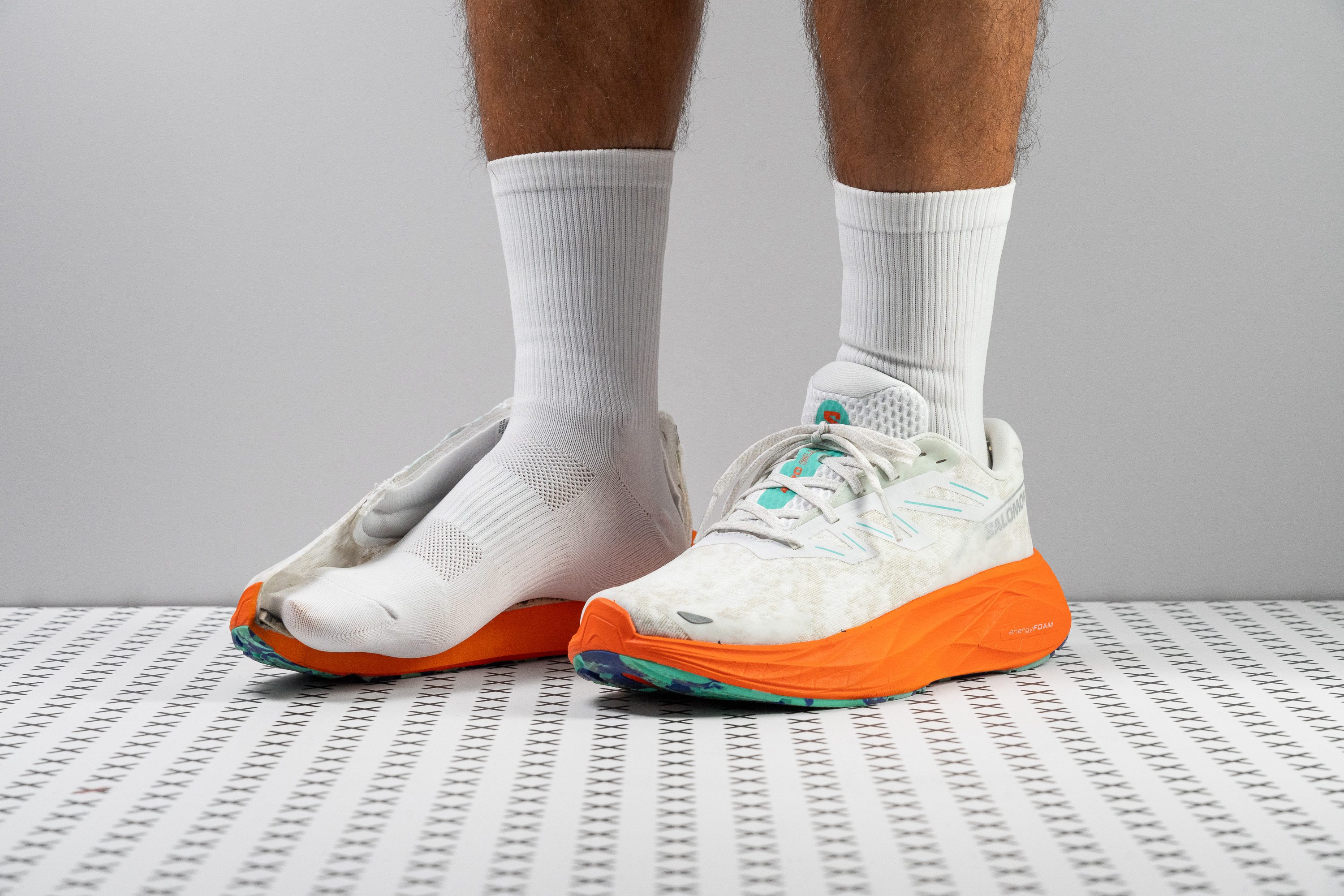Nuestra conclusión
Pros
- Reflectantes por todas partes
- Ligeras para su tamaño
- Upper mejorado
- Muy estables
- Ideales para los talonadores
- Suela exterior bien protegida
- Para las tiradas diarias
- También son ideales para el invierno
Contras
- Demasiado rígidas
- Todavía no tienen una lengüeta reforzada
- Suela más baja de lo esperado
- La mediasuela se siente plana
Veredicto de los usuarios
- Top 2% entre Zapatillas de running para asfalto
- Top 2% entre zapatillas de running neutras
Comparativa
Las zapatillas de running más parecidas
+ + Añadir unas zapatillas | |||||
|---|---|---|---|---|---|
| Puntuación global | 93 Excelentes | 91 Excelentes | 92 Excelentes | 90 Excelentes | |
| Precio | 160 € | 190 € | 160 € | 190 € | |
| Pace | Correr a diario | Correr a diario | Correr a diario | Correr a diario | |
| Absorción de impactos | Moderada | Alta | Alta | Alta | |
| Retorno de energía | Bajo | Moderado | Alto | Moderado | |
| Tracción | Alta | Alta | Alta | Alta | |
| Arch support | Neutral | Neutral | Neutral | Neutral | |
| Peso laboratorio Peso marca | 9.5 oz / 268g 9.2 oz / 260g | 10.3 oz / 291g 10.3 oz / 292g | 8.7 oz / 248g 8.6 oz / 245g | 9.6 oz / 272g 9.7 oz / 275g | |
| Lightweight | ✗ | ✗ | ✓ | ✗ | |
| Drop laboratorio Drop marca | 11.3 mm 10.0 mm | 9.6 mm 8.0 mm | 10.3 mm 8.0 mm | 9.4 mm 6.0 mm | |
| Técnica de carrera | Talón | TalónMedio/antepié | Talón | TalónMedio/antepié | |
| Talla | Tallan bien | Tallan bien | Tallan un poquito grande | Tallan bien | |
| Rigidez de la mediasuela | Equilibrada | Blanda | Equilibrada | Equilibrada | |
| Diferencia de la rigidez de la mediasuela en frío | Pequeña | Grande | Pequeña | Pequeña | |
| Durabilidad de la parte delantera | Buena | Decente | Mala | Decente | |
| Durabilidad del acolchado del talón | Media | Media | Media | Baja | |
| Durabilidad de la suela exterior | Decente | Decente | Decente | Buena | |
| Transpirabilidad | Media | Media | Media | Media | |
| Anchura / ajuste | Media | Media | Estrecha | Media | |
| Anchura de la parte delantera | Media | Media | Estrecha | Media | |
| Flexibilidad | Moderada | Rígida | Moderada | Rígida | |
| Rigidez torsional | Rígidas | Rígidas | Rígidas | Rígidas | |
| Rigidez del contrafuerte del talón | Moderado | Moderado | Flexible | Moderado | |
| Rocker | ✓ | ✓ | ✗ | ✓ | |
| Talón laboratorio Talón marca | 35.5 mm 41.0 mm | 42.9 mm 47.0 mm | 42.2 mm 40.0 mm | 39.9 mm 37.0 mm | |
| Antepié laboratorio Antepié marca | 24.2 mm 31.0 mm | 33.3 mm 39.0 mm | 31.9 mm 32.0 mm | 30.5 mm 31.0 mm | |
| Anchuras disponibles | Estándar | Estándar | Estándar | Estándar | |
| Orthotic friendly | ✓ | ✓ | ✓ | ✓ | |
| Estación | Todas las estaciones | Todas las estaciones | Todas las estaciones | Todas las estaciones | |
| Removable insole | ✓ | ✓ | ✓ | ✓ | |
| Clasificación | #10 Top 2% | #32 Top 9% | #10 Top 3% | #40 Top 11% | |
| Popularidad | #511 23% inferior | #136 Top 37% | #102 Top 28% | #203 45% inferior |
Quién debería comprárselas
Después de hacerles montones de pruebas tanto dentro como fuera de nuestro laboratorio, estamos encantados de poder decirte que las Salomon Aero Glide 2 son:
- Una actualización excepcional para los fans de las originales que mejora la parte superior manteniendo la misma versatilidad.
- Unas zapatillas ideales para el día a día si prefieres un drop alto, ya que les proporcionan a los talonadores la sujeción que necesitan.
- Unas compañeras perfectas para correr por asfalto para los fans de los modelos de trail de Salomon, ya que la transición a correr por carretera es fluida y estable.
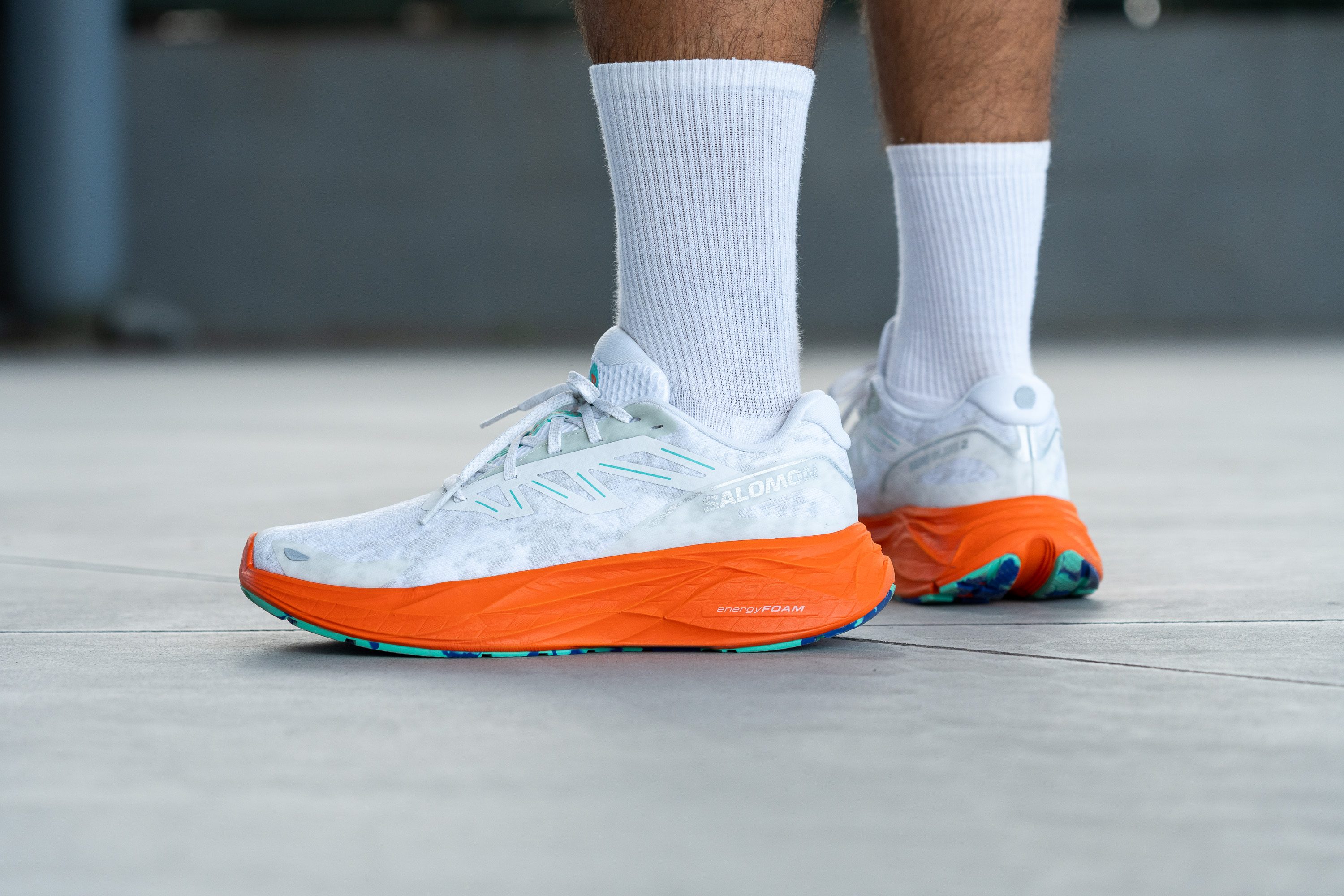
Quién NO debería comprárselas
Creemos que las Aero Glide 2 se les quedan cortas a los corredores que están buscando unas zapatillas de entrenamiento diario flexibles. Su estructura rígida hace que sean muy difíciles de doblar, así que, en nuestra experiencia, puede que no sean la mejor opción si lo que quieres es una pisada natural. Como alternativa, no dudes en echarle un ojo a las Brooks Ghost 16 o a las Altra Experience Flow.
Además, creemos que este modelo tampoco es la mejor opción para los corredores de metatarsos y de mediopié, ya que su alto drop de 11,3 mm no se adapta a estas técnicas de carrera. Si estás buscando unas zapatillas con drop bajo, te recomendamos las ASICS Noosa Tri 16 o las New Balance Fresh Foam More v5.
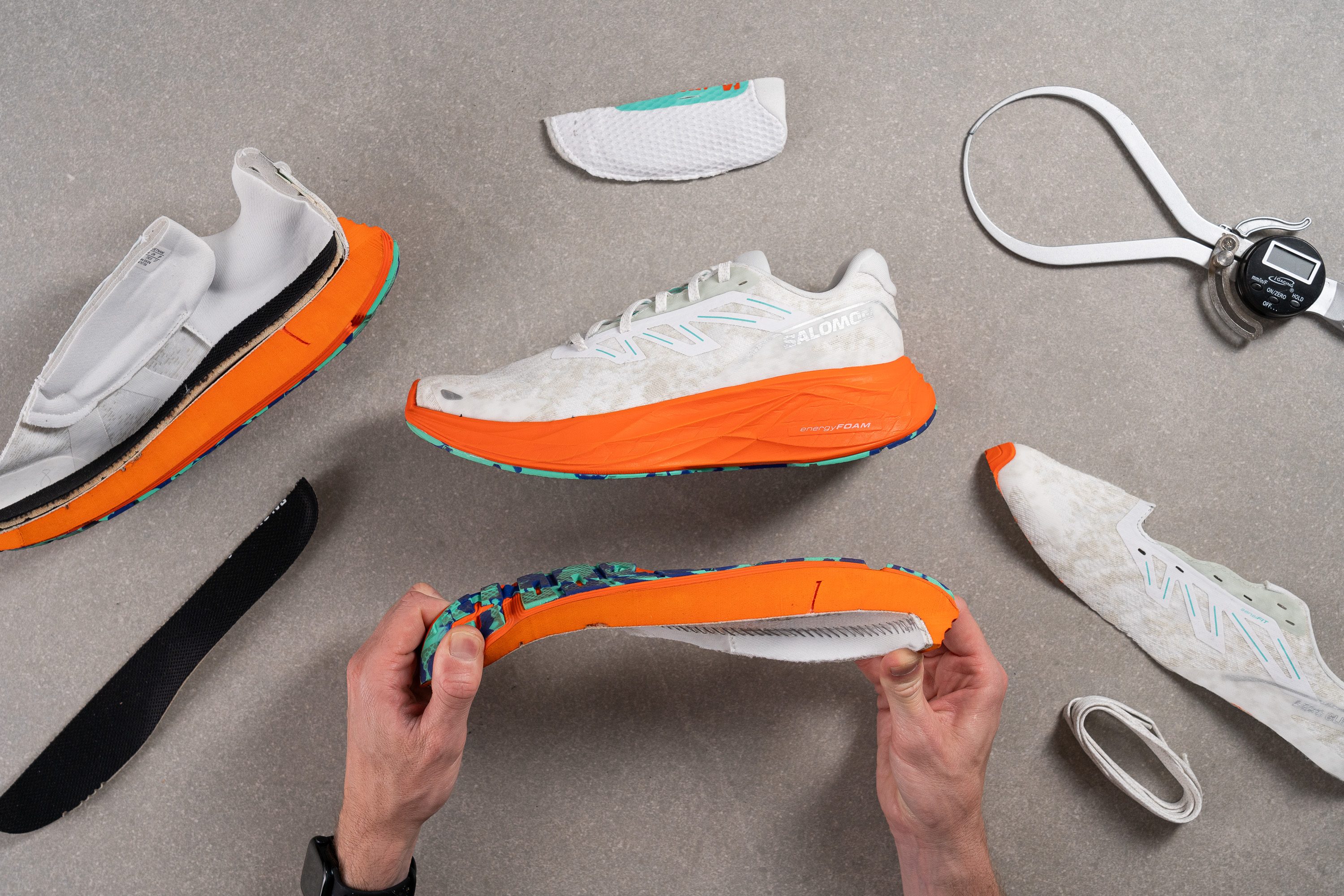
Amortiguación
Shock absorption
Las Aero Glide 2 tienen una mediasuela con paredes laterales grandes que, a primera vista, a lo mejor te hacen pensar que la pisada es mullida, pero nuestra prueba ASTM F1976 dice otra cosa.
El resultado fue de 118 SA en el talón y solo 92 SA en el antepié. Ambos son números que alejan a estas zapatillas de los modelos con amortiguación máxima, demostrándonos que son más adecuadas para las carreras cortas o los corredores ligeros.
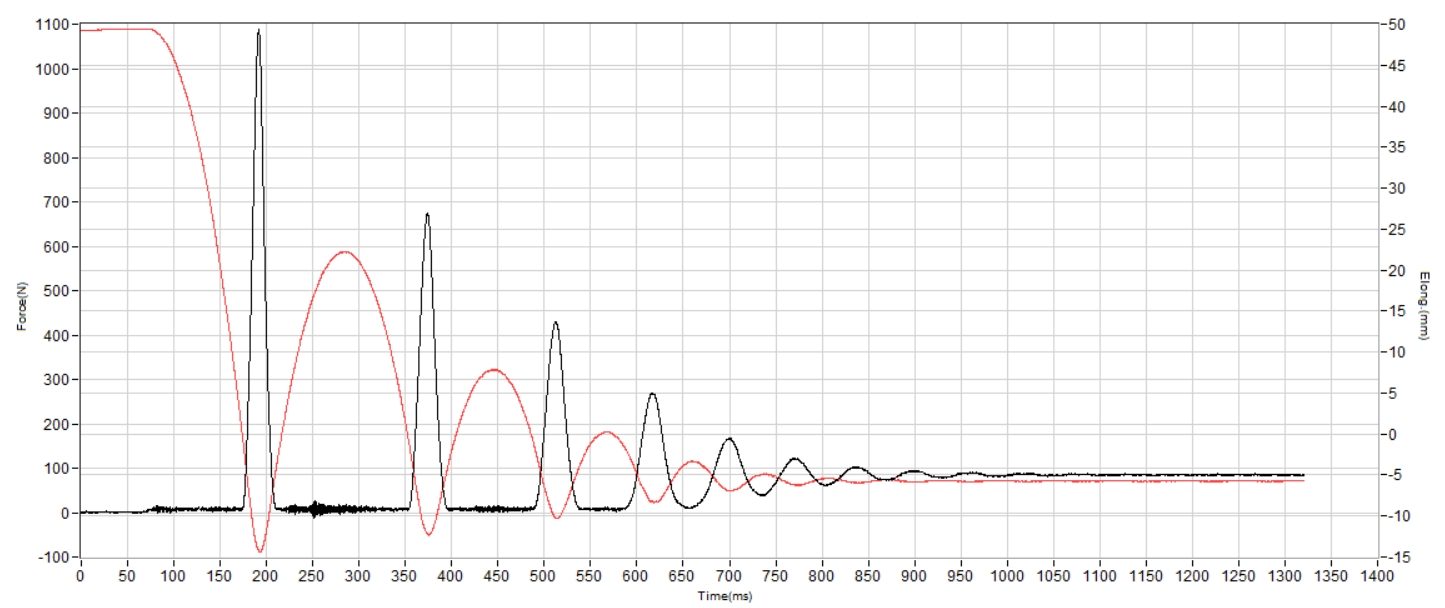
| Aero Glide 2 | 118 SA |
| Media | 129 SA |
Energy return
El retorno de energía está un poco por debajo de nuestras expectativas, ya que las Aero Glide 2 alcanzaron solo el 50,7 %. Eso sí, la verdad es que tampoco nos sorprendimos: la espuma Energy de Salomon es una mezcla de EVA + OBC, parecida a la FF Blast+ de ASICS, y generalmente también ronda el 50 %.
| Aero Glide 2 | 50.7% |
| Media | 58.5% |
Altura de la suela en la zona del talón
Salomon dice que este modelo tiene una altura de la suela en el talón de 41 mm, pero nuestro calibre dice que nanay, ya que marcó solo 35,5 mm.
Incluso con esta discrepancia, creemos que la mayoría de los talonadores sentirán que 35,5 mm son suficientes tanto para correr a diario como para enfrentarse a largas distancias, ya que ofrecen mucha amortiguación.
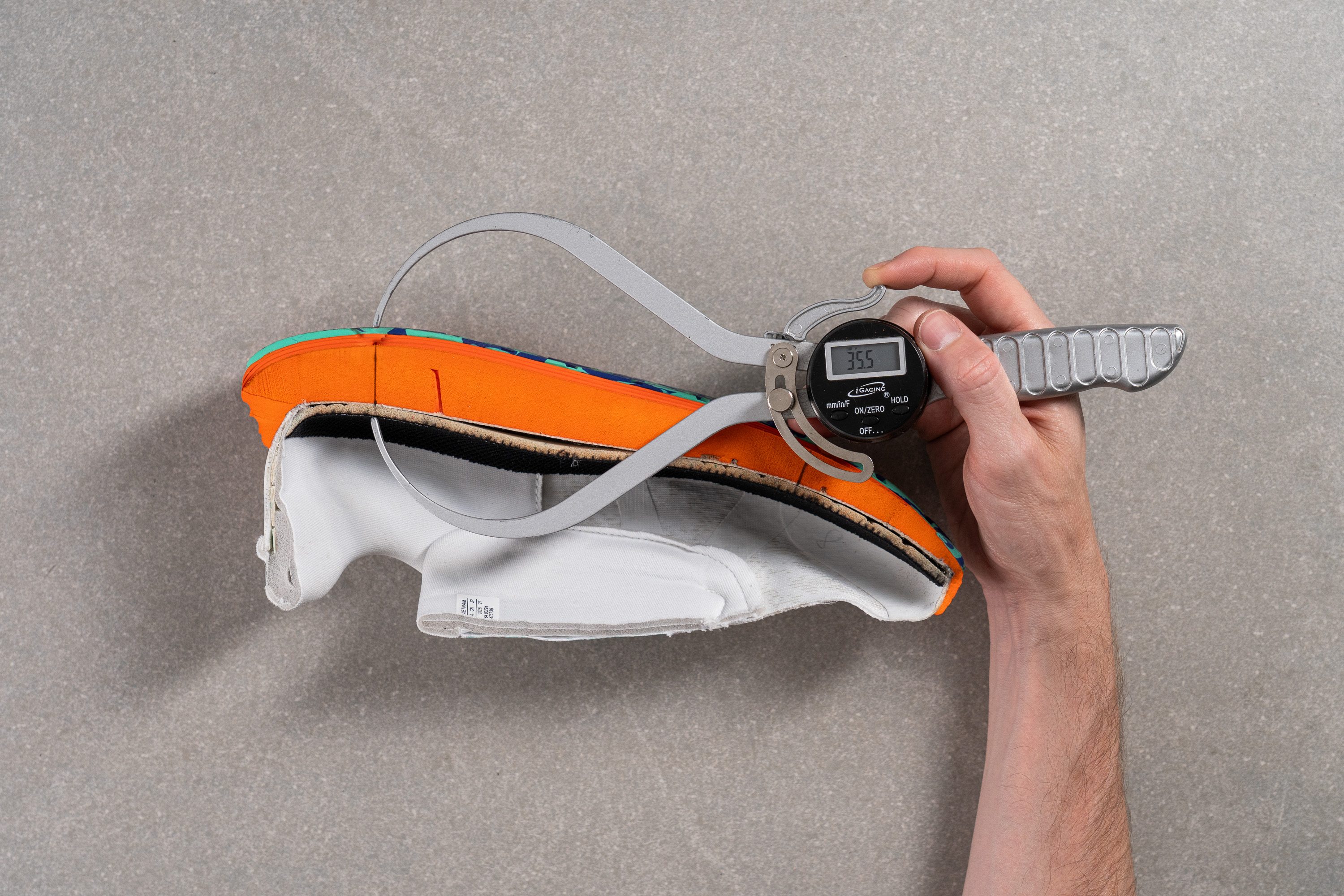
| Aero Glide 2 | 35.5 mm |
| Media | 34.8 mm |
Altura de la suela en el antepié
La altura de la suela en el antepié es un poco más baja de lo que nos esperábamos, ya que nuestro calibre marcó 24,2 mm.
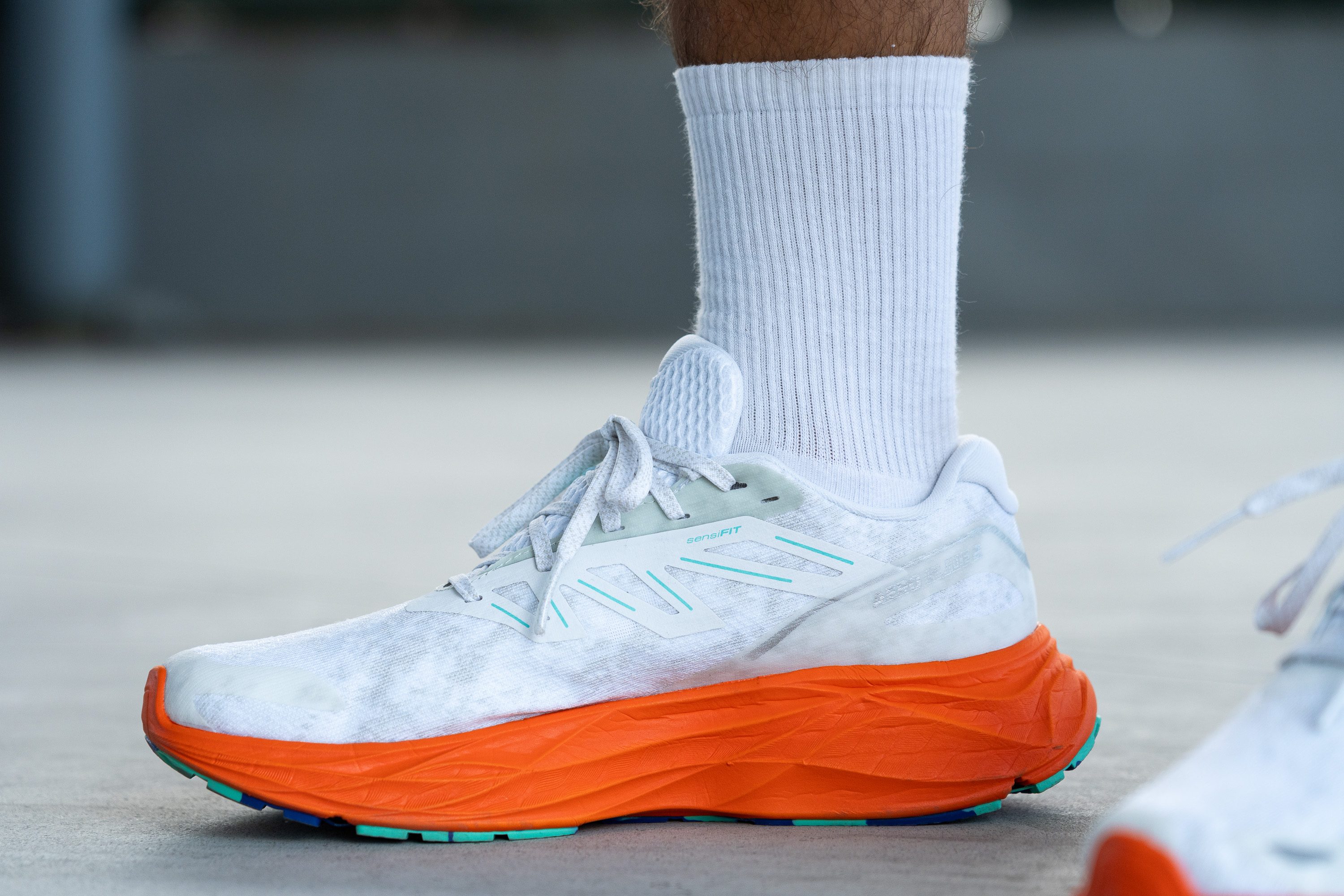
Aunque es un resultado inferior a la media, la verdad es que no nos ha cogido por sorpresa, ya que coincide exactamente con la versión anterior.
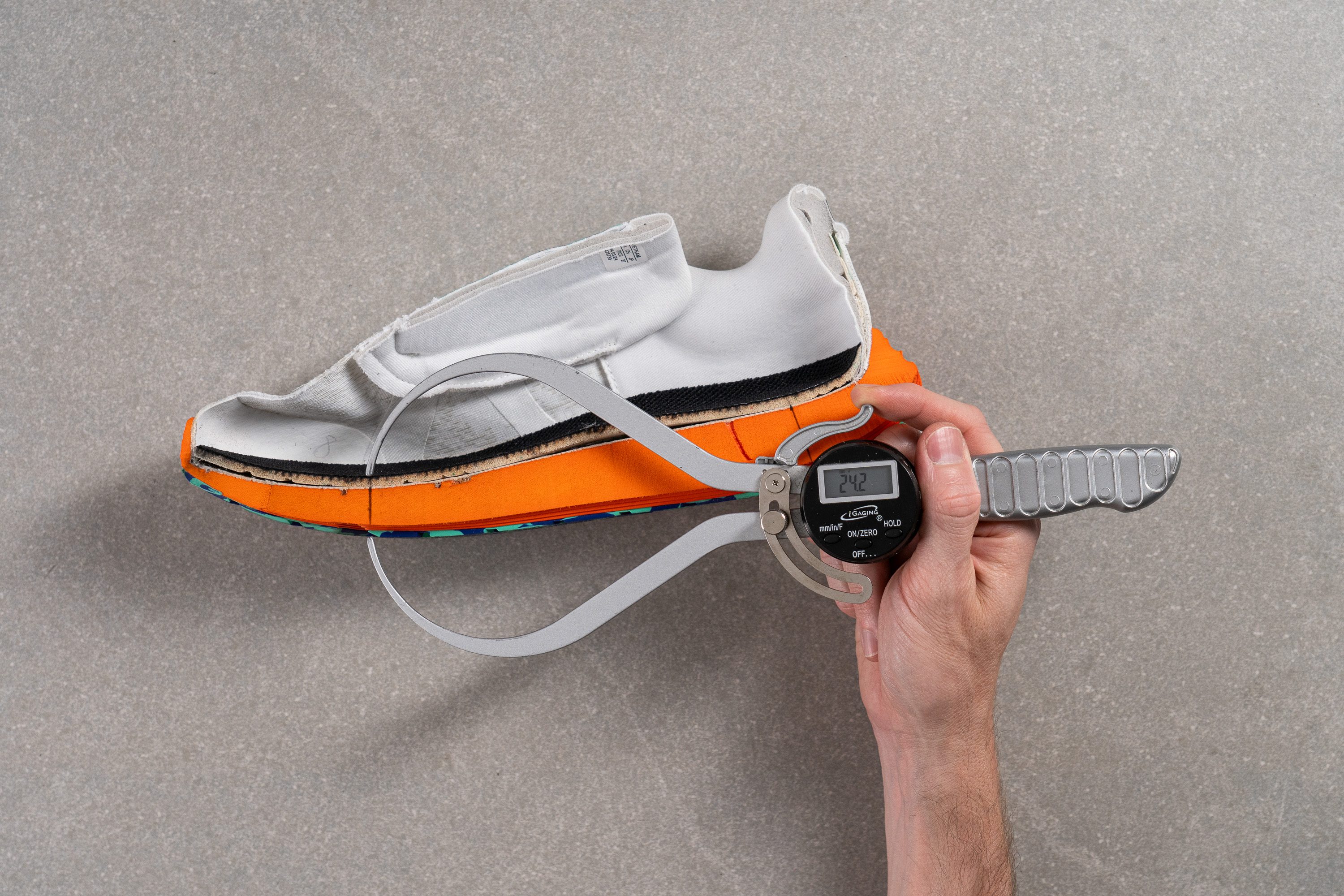
| Aero Glide 2 | 24.2 mm |
| Media | 26.2 mm |
Drop
Salomon dice que el drop es de 10 mm, pero a nosotros nos dio 11,3 mm. Aunque sean dos cifras diferentes, ambos siguen siendo drops altos que hacen que las zapatillas tengan un diseño de cuña. Aunque están pensadas principalmente para los talonadores, un drop alto le puede ir bien a cualquiera, sobre todo a las personas propensas a tener problemas en las pantorrillas y en el tendón de Aquiles.
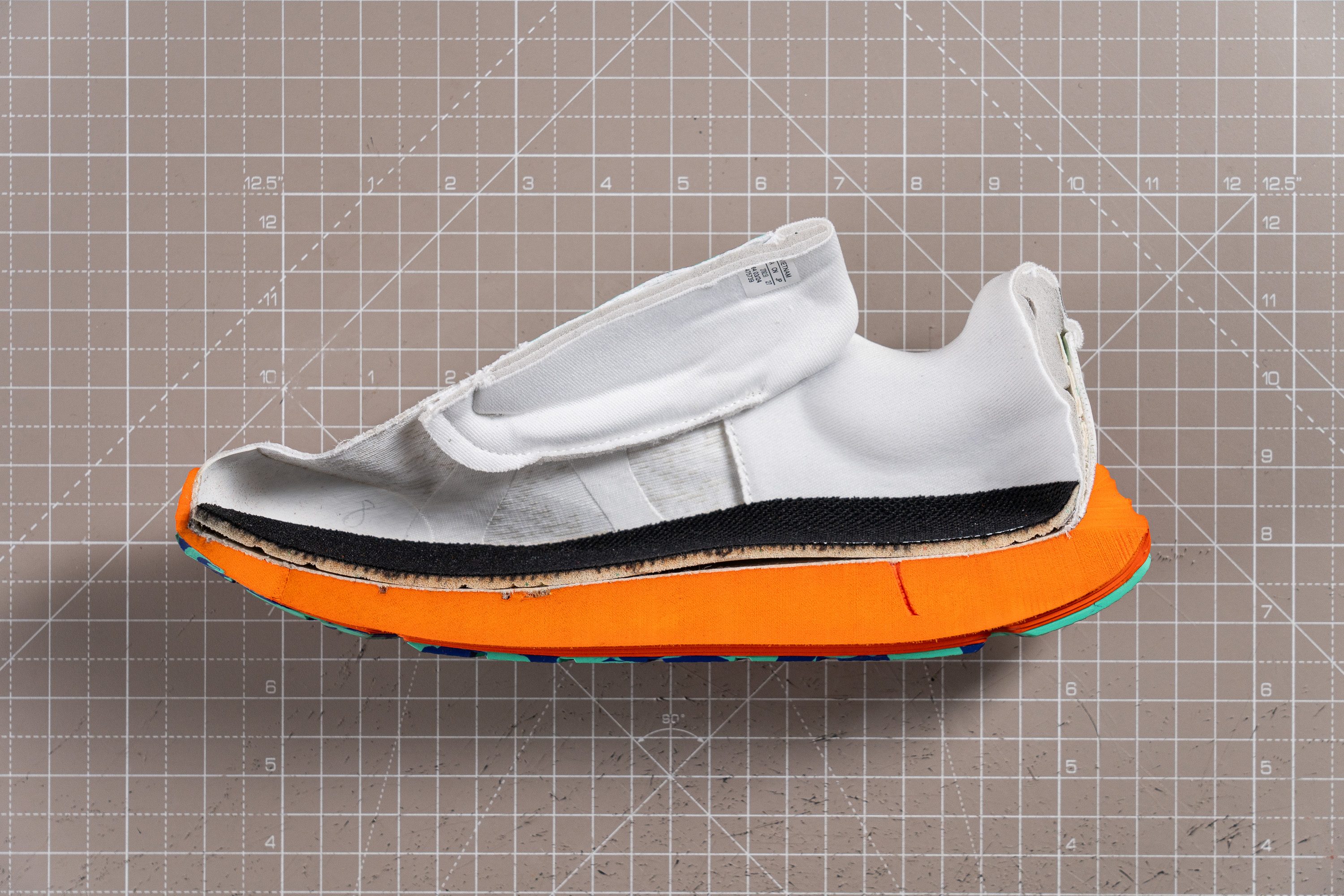
| Aero Glide 2 | 11.3 mm |
| Media | 8.6 mm |
Suavidad de la mediasuela
La mediasuela de las Aero Glide 2 está fabricada totalmente con Energy Foam de Salomon (una mezcla a base de EVA mejorada con olefina para una mayor resistencia). En su formulación, imita a la Helion de On Running y ofrece una sensación muy parecida bajo los pies, pero sin tener las míticas nubes de esta marca, claro.
Esta mediasuela ofrece una sensación equilibrada y estable que nos parece ideal para las personas que prefieren que sea segura a que sea mullida. Además, consigue que el pie esté bien sujeto, evitando que se chafe en la zona del antepié, que es algo muy importante porque esta zona tiene menos amortiguación.
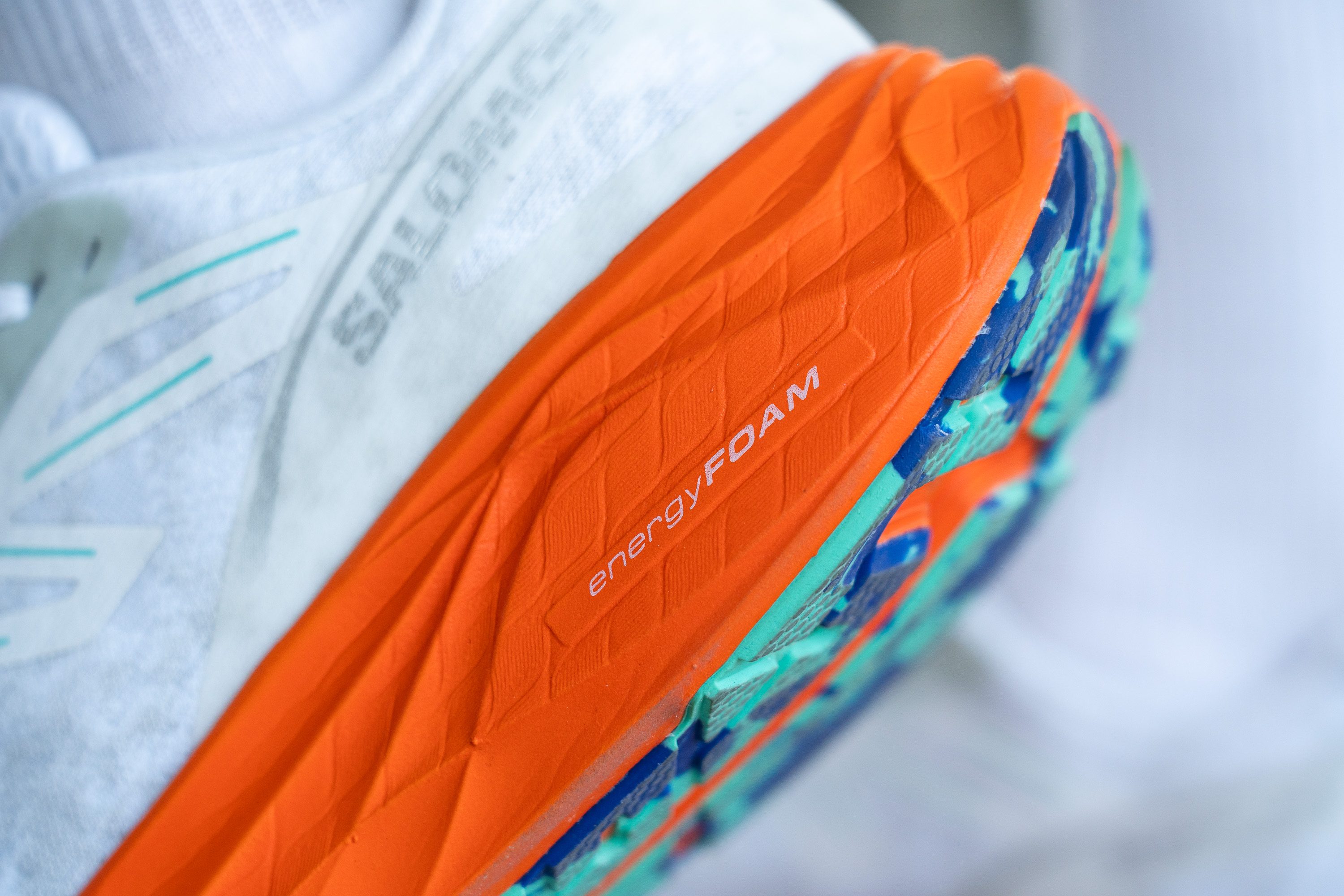
El retorno de energía en este modelo se mantiene en la línea de sus predecesoras y de las típicas zapatillas de entrenamiento diario: vamos, que es decente, pero no tan increíble como la mediasuela basada en Pebax de las Nike Invincible 3. Aunque esta característica no hace que las zapatillas destaquen, tampoco es un inconveniente, ni muchísimo menos.

| Aero Glide 2 | 22.5 HA |
| Media | 20.4 HA |
Rocker
Las Aero Glide 2 cuentan con el "Reverse Camber" de Salomon, un término que utilizan para describir un rocker inspirado en el esquí que empieza en el mediopié y se curva suavemente en la zona de los dedos, algo que hemos visto en muchos otros modelos. Como el drop de este es alto y su amortiguación es media, no necesitamos que la parte de los dedos tenga una curvatura más agresiva.
Eso sí, Salomon... creemos que no hay que estar poniéndoles nombres extravagantes a las características estándar de unas zapatillas.
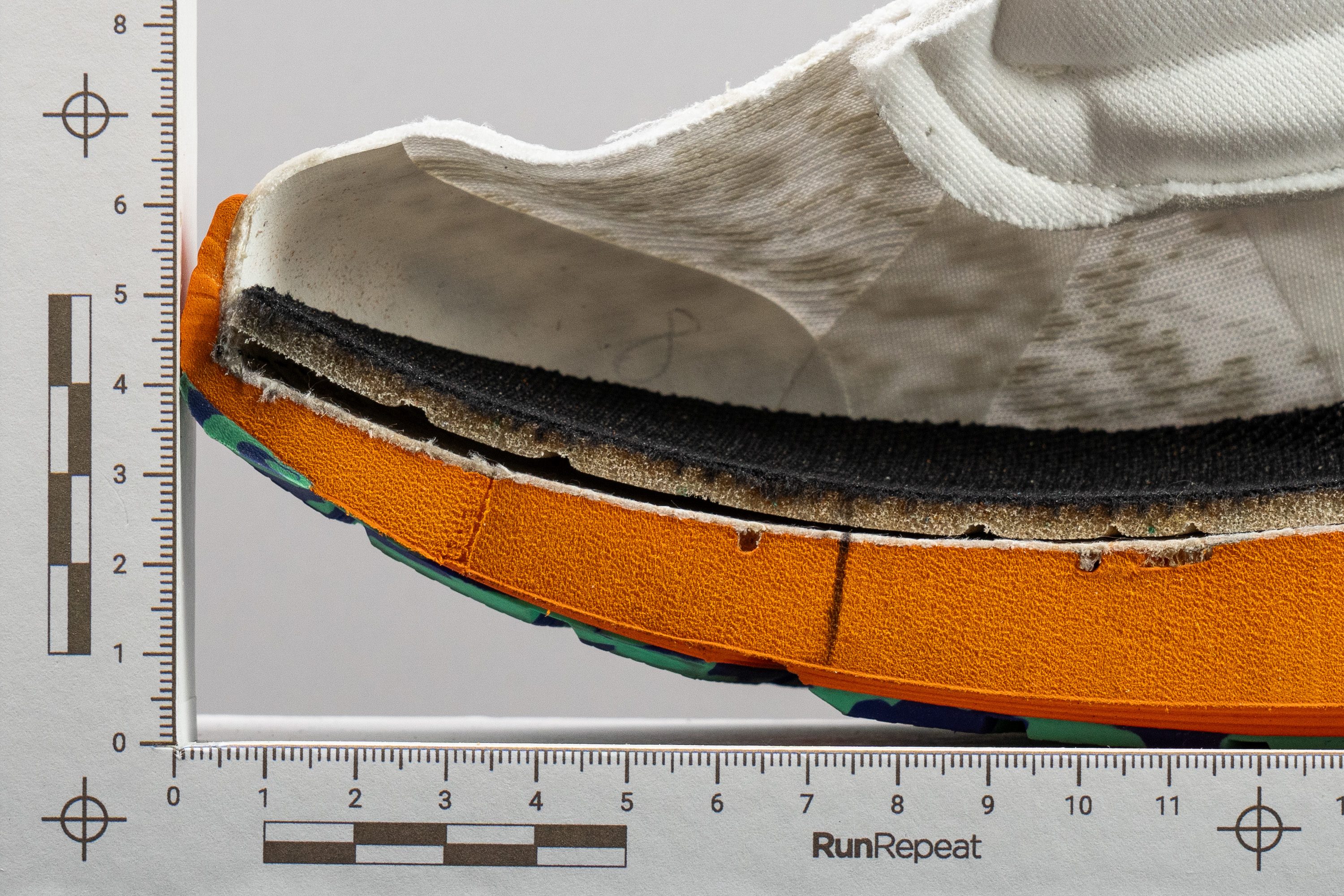
Tallaje y ajuste
Talla
Las Salomon Aero Glide 2 tallan bien (24 votos).
Width / Fit
We've noticed a trend towards more generous toebox designs lately, and the Aero Glide 2 perfectly embodies this shift, offering a widened 99.8 mm across its widest upper section—an uptick from the earlier 98.5 mm of v1.
Additionally, our evaluations revealed a subtle yet significant boost in toebox height, enhancing comfort for those with larger feet. This broader design is crucial since the shoe is available only in standard width.
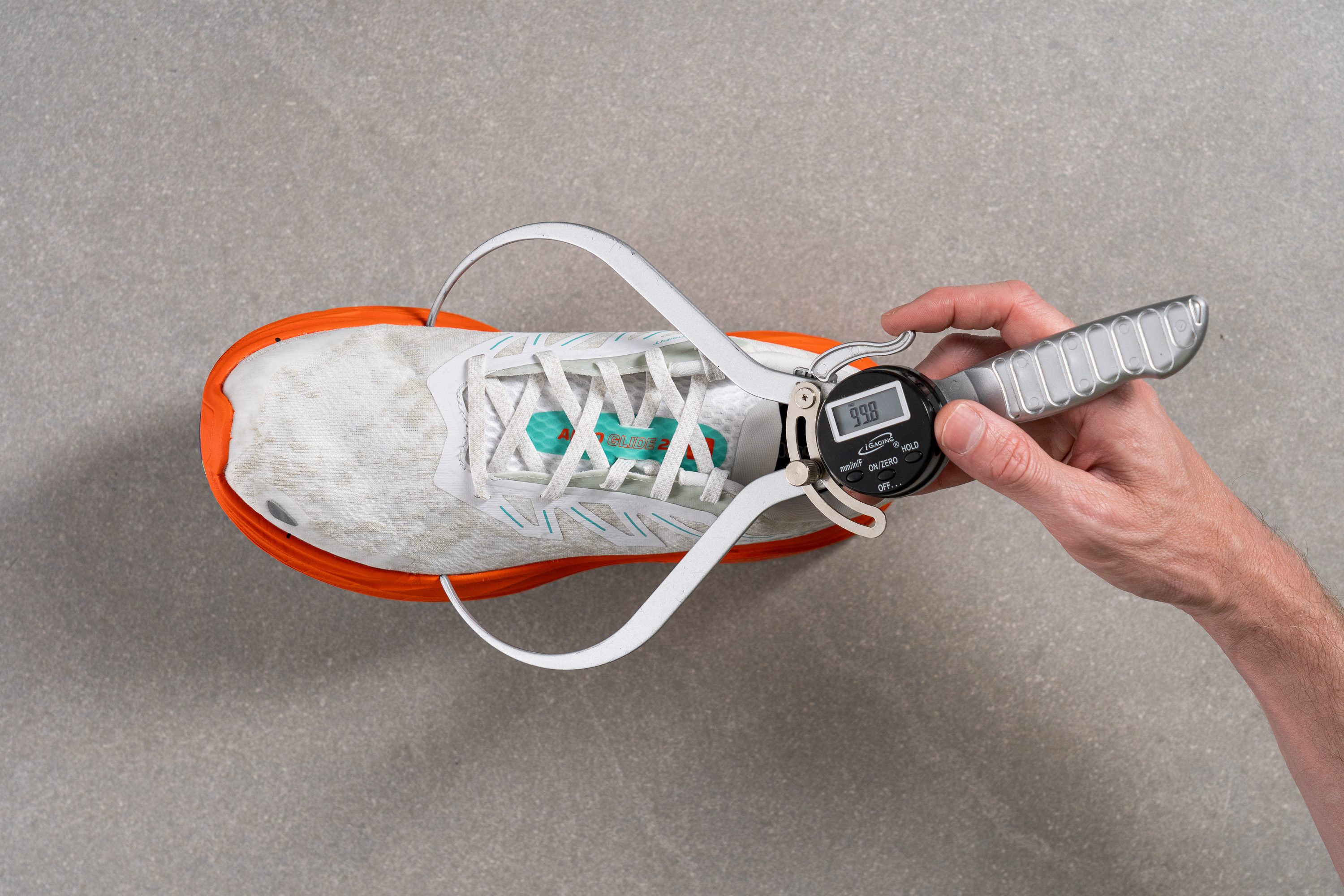
En esta prueba se utiliza una metodología antigua, así que no verás las zapatillas que hemos analizado últimamente en la tabla. Los resultados obtenidos con metodologías distintas no se pueden comparar.
| Aero Glide 2 | 99.8 mm |
| Media | 98.5 mm |
Toebox width
However, we found that the upper tapers excessively—narrowing down to a snug 76.4mm in the big toe area. This could be a deal-breaker for those with really wide feet.
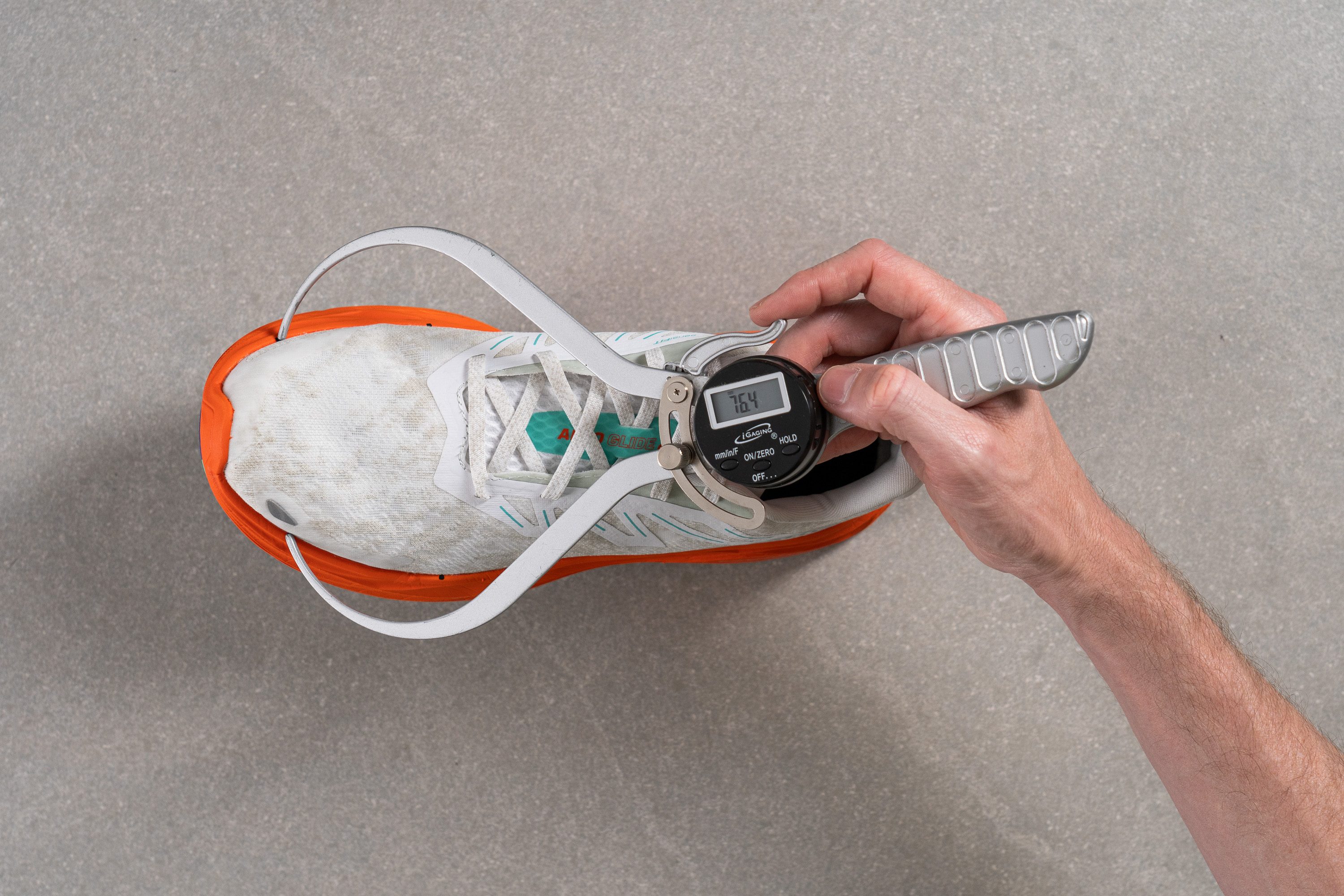
En esta prueba se utiliza una metodología antigua, así que no verás las zapatillas que hemos analizado últimamente en la tabla. Los resultados obtenidos con metodologías distintas no se pueden comparar.
| Aero Glide 2 | 76.4 mm |
| Media | 78.4 mm |
Tracción / Agarre
Traction test
Analizamos las Aero Glide 2 y las sentimos consistentemente estables incluso sobre asfalto mojado. No te vamos a engañar, la verdad es que no nos pilló por sorpresa: Salomon es experta en las suelas exteriores inspiradas en el trail. El compuesto CONTAGRIP se llevó un fiable 0,47 en nuestro laboratorio, lo que demuestra que estas zapatillas listas para el asfalto se agarran bien tanto a las superficies secas como a las mojadas.
| Aero Glide 2 | 0.47 |
| Media | 0.48 |
Diseño de la suela exterior
También descubrimos que la cobertura de caucho de la suela exterior de este modelo destaca entre las zapatillas de entrenamiento diario. Estamos ante un cambio de diseño importante con respecto al estándar, ya que tiene un corte central muy grande y cortes horizontales en el talón y en el antepié.
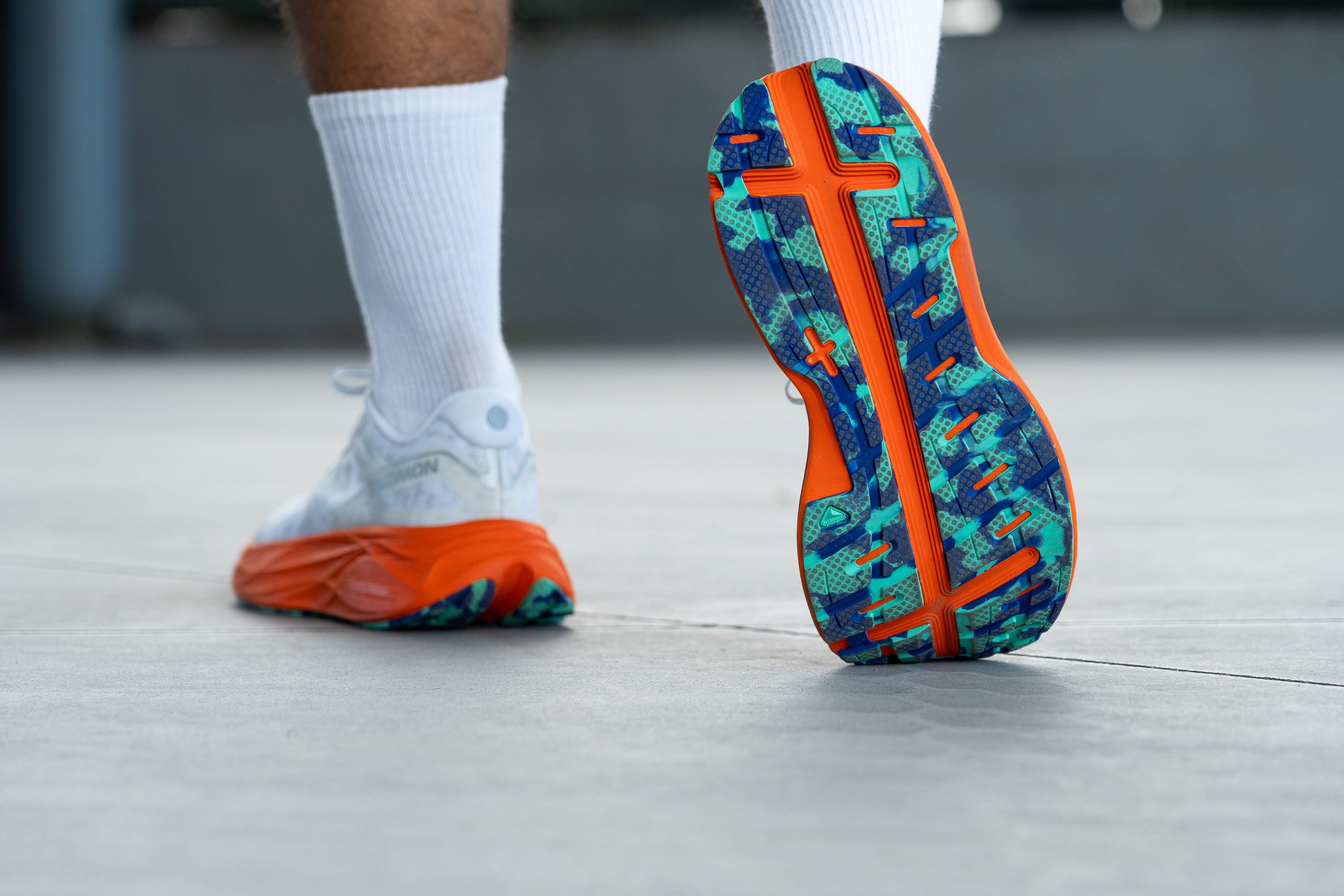
Flexibilidad / Rigidez
Estas zapatillas tienen una rigidez torsional alta, pero longitudinalmente son bastante flexibles, lo que las hace más cómodas para las salir a correr, trotar, o pasear.
En nuestra prueba de flexión de 30 grados, la máquina marcó que se necesitan 16,9 N de fuerza para doblarlas, que es un resultado que se corresponde con las zapatillas de entrenamiento diario modernas.
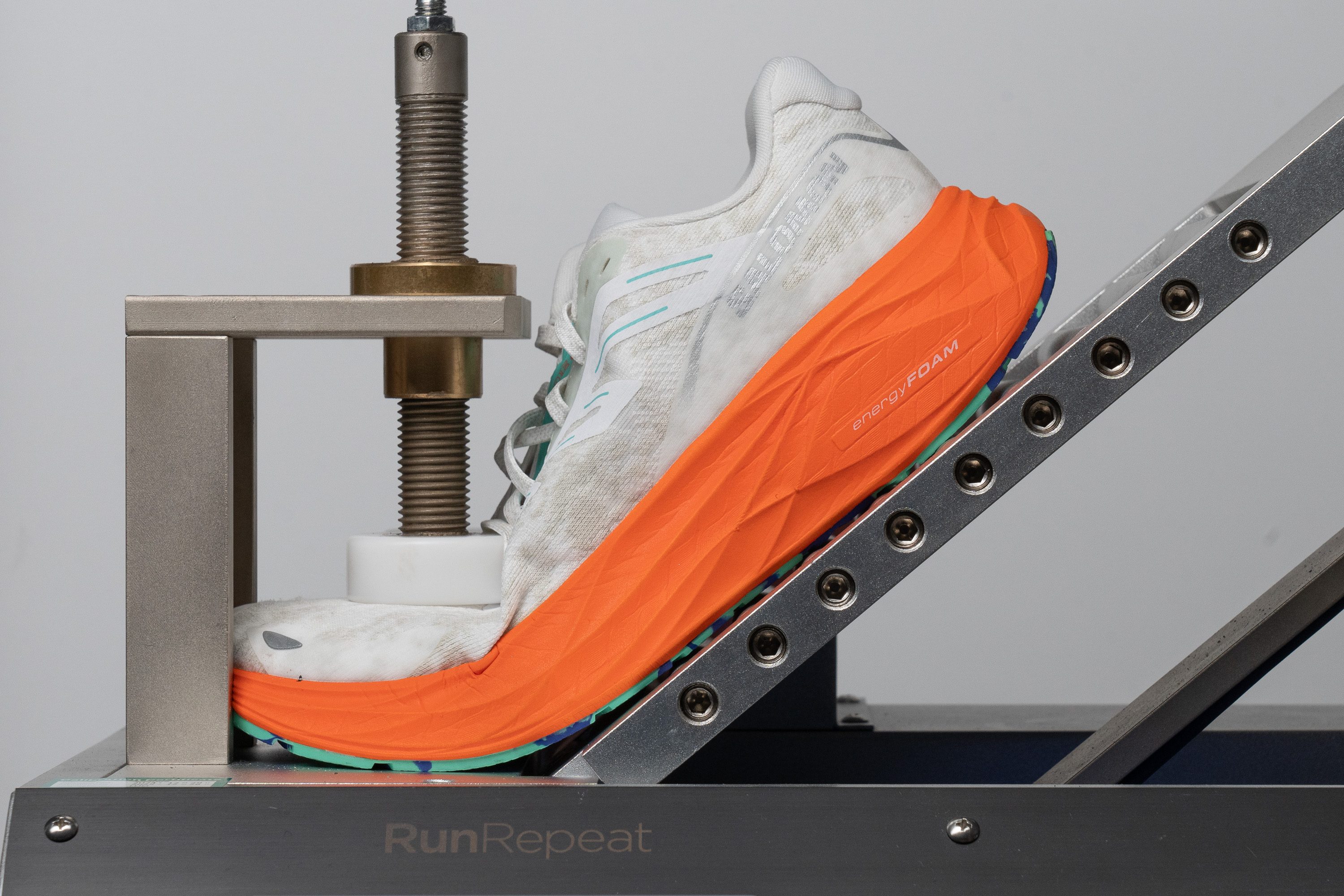
| Aero Glide 2 | 16.9N |
| Media | 15.3N |
Rigidez en frío (%)
Después de realizar otra ronda de pruebas en nuestro congelador, nos quedamos boquiabiertos, ya que la rigidez aumentó solo en un 26,7 %. Este resultado vuelve a dejar claro que la mezcla de EVA+OBC que Salomon utiliza en la mediasuela Energy Foam ha sido todo un acierto.
| Aero Glide 2 | 27% |
| Media | 33% |
Peso
Los 268 g de las Aero Glide 2 hacen que pesen lo mismo que sus predecesoras. La verdad es que son muy buenas noticias, sobre todo porque esta parte superior rediseñada mejora bastante la comodidad. Además, esta actualización tiene más caucho que cubre la mediasuela.
En cuanto a peso, nos parece que este par consigue mantener un equilibrio excelente en comparación con otras zapatillas de entrenamiento diario con amortiguación. Aunque no es tan ligero como algunas de sus competidoras, como las Hoka Mach 6, consigue estar por debajo de los 280 g. ¡Buen trabajo, Salomon!
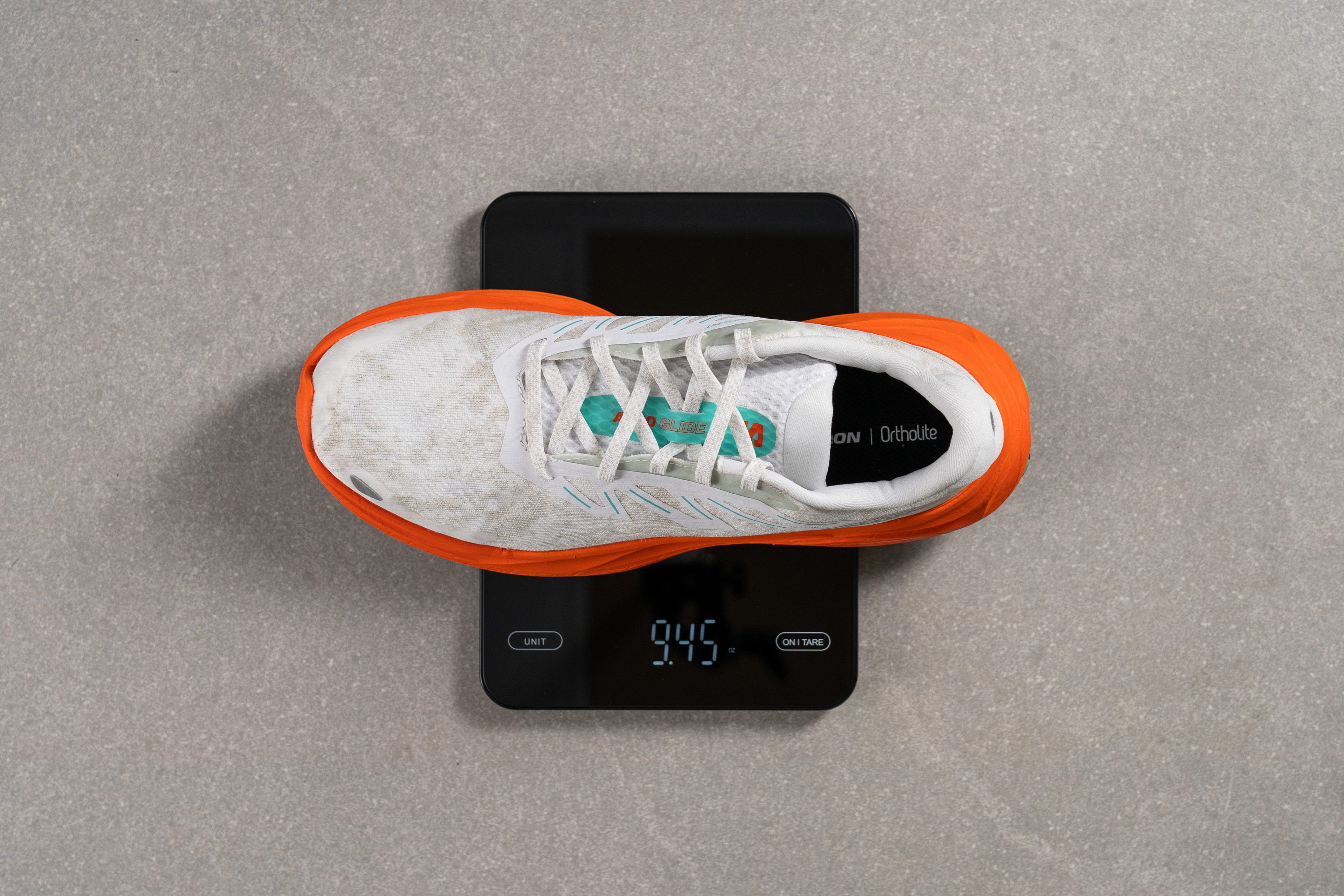
| Aero Glide 2 | 9.5 oz (268g) |
| Media | 9.3 oz (264g) |
Transpirabilidad
Cuando analizamos el upper de las Aero Glide 2 nos pareció muy mullido y cómodo, pero como no le vimos agujeritos para el aire, empezamos a dudar sobre su transpirabilidad.
Durante nuestra prueba de humo, vimos que estas zapatillas dejaban salir un montón de aire de su interior, sorprendiéndonos positivamente. Se llevaron un maravilloso 4/5 en transpirabilidad, confirmando así que dejan salir el calor de forma eficiente.
En lugar de tener muchos agujeritos de ventilación, Salomon utilizó una malla de alta calidad, muy fina y de densidad variable. Esta elección de diseño deja que el aire se escape por puntos clave como la zona de los dedos y los laterales, garantizando la transpirabilidad sin comprometer la estructura de las zapatillas.
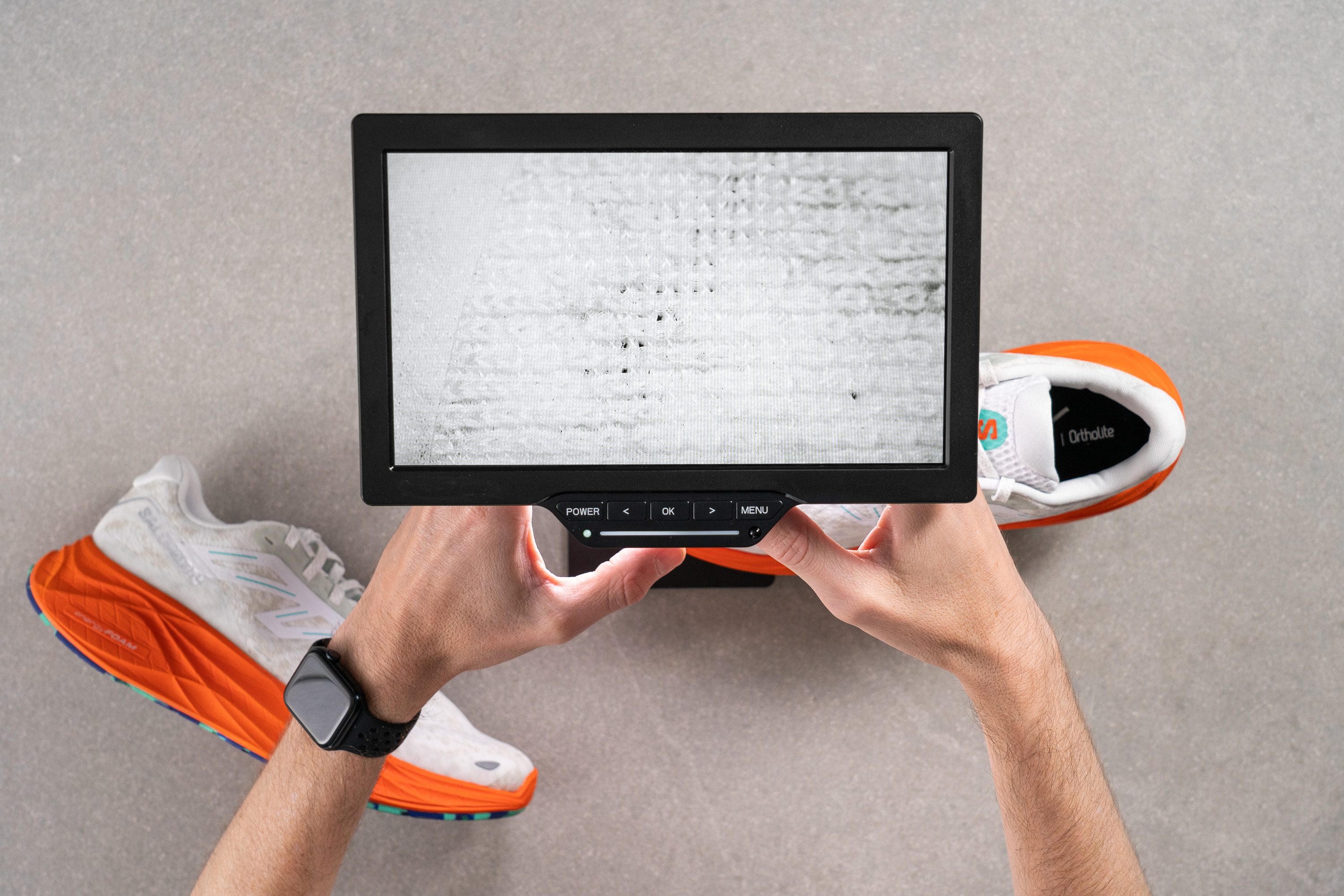
Cuando las estudiamos con nuestro microscopio, entendimos mucho mejor el enfoque de Salomon. Al contrario que muchas otras marcas, decidió poner la capa estructural en el exterior y un material más suave en el interior, muy probablemente con el objetivo de aumentar la comodidad.
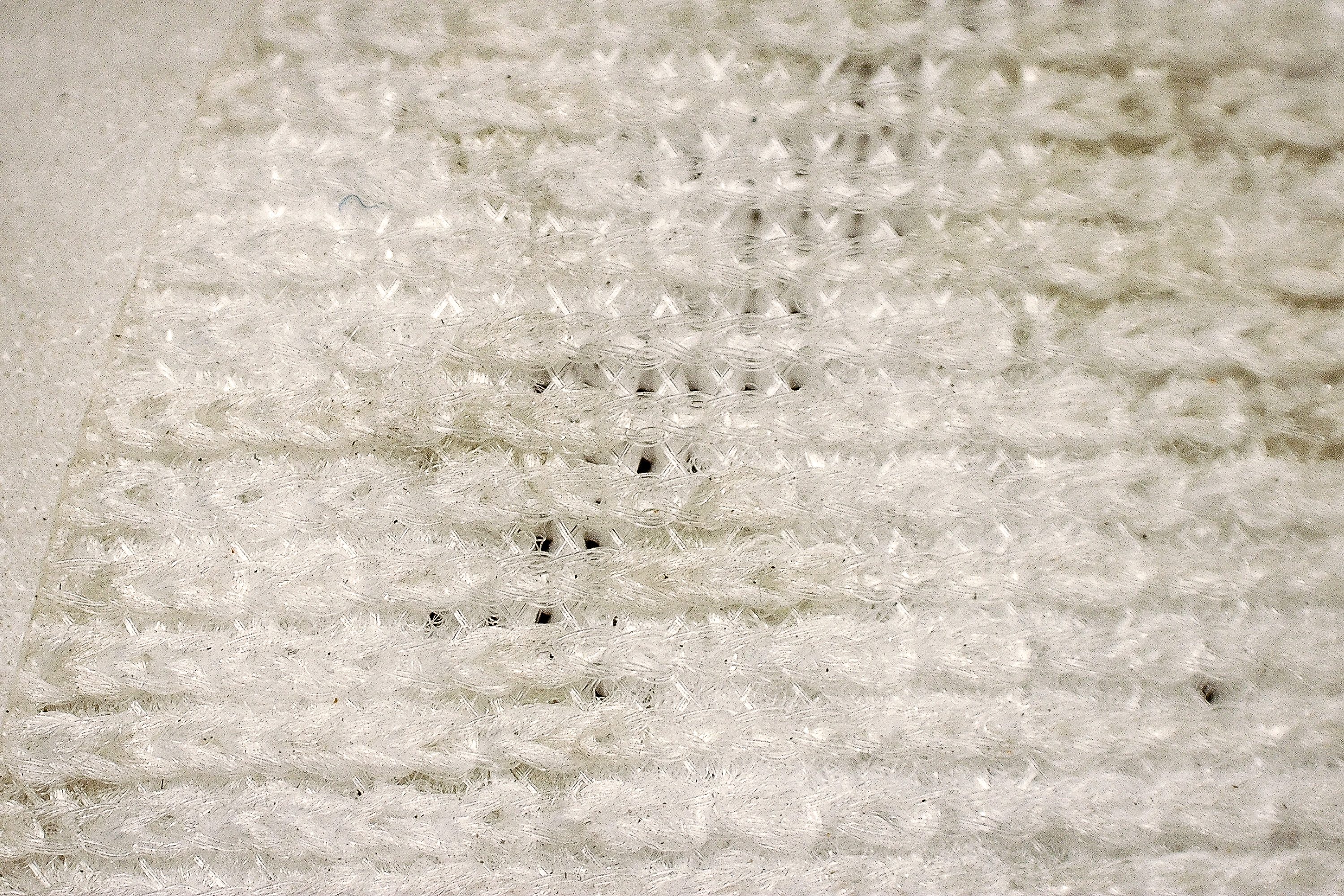
En general, creemos que la parte superior de malla 3D de las Aero Glide 2 es una maravilla. Evita estratégicamente las costuras que pueden hacerte rozaduras y tiene acolchado justo donde se necesita, como en el talón. Además, consigue mantener un peso bastante bajo.
| Aero Glide 2 | 4 |
| Media | 3.7 |
Estabilidad
Prueba de estabilidad lateral
Desde el punto de vista de la estabilidad, estas zapatillas son neutras, pero ofrecen mucha sujeción gracias a varias mejoras en su diseño: unas pareces laterales de la mediasuela altas, un talón biselado importante y un corte longitudinal marcado. Todo esto ayuda a que la pisada esté más centrada al correr.
Rigidez torsional
Eso sí, lo malo de las Aero Glide 2 es que su pisada no tiene la flexibilidad que ofrecen las zapatillas de entrenamiento diario que algunos corredores prefieren; es mucho más rígida, y se parece a la de algunos modelos de estabilidad suave como las Hoka Arahi 7.
En nuestra evaluación manual, estas Salomon se han llevado un 5/5 en rigidez torsional.
| Aero Glide 2 | 5 |
| Media | 3.5 |
Rigidez del contrafuerte del talón
Salomon vuelve a acercar las Aero Glide 2 al grupo de las zapatillas de entrenamiento diario al ponerles un contrafuerte en el talón parecido al de modelos como las On Cloudmonster 2, que se llevó una puntuación estándar en rigidez: un 3/5.
En nuestra experiencia, esto consigue que las zapatillas ofrezcan un buen equilibrio, ya que proporcionan la sujeción suficiente para estabilizar el talón de forma eficaz sin hacer que sea demasiado rígido o molesto. Además, este detalle es importantísimo para un modelo diseñado para ser respetuoso con el tendón de Aquiles.
| Aero Glide 2 | 3 |
| Media | 2.9 |
Anchura de la mediasuela - antepié
Con una anchura de 120,6 mm, las AG2 son bastante anchas, igual que las zapatillas de estabilidad, que suelen ofrecer una buena base de apoyo.
A los corredores con una técnica neutra perfecta a lo mejor se les hace demasiado, pero los que tienen pronación o supinación leves la encontrarán muy útil.

| Aero Glide 2 | 120.6 mm |
| Media | 114.4 mm |
Anchura de la mediasuela - talón
En su parte más ancha, el talón de estas zapatillas mide 97,5 mm, imitando así la amplitud del antepié. Que sea gigantesco es ideal para los talonadores, confirmando nuestra hipótesis de que Salomon diseñó las Aero Glide 2 pensando en ellos.
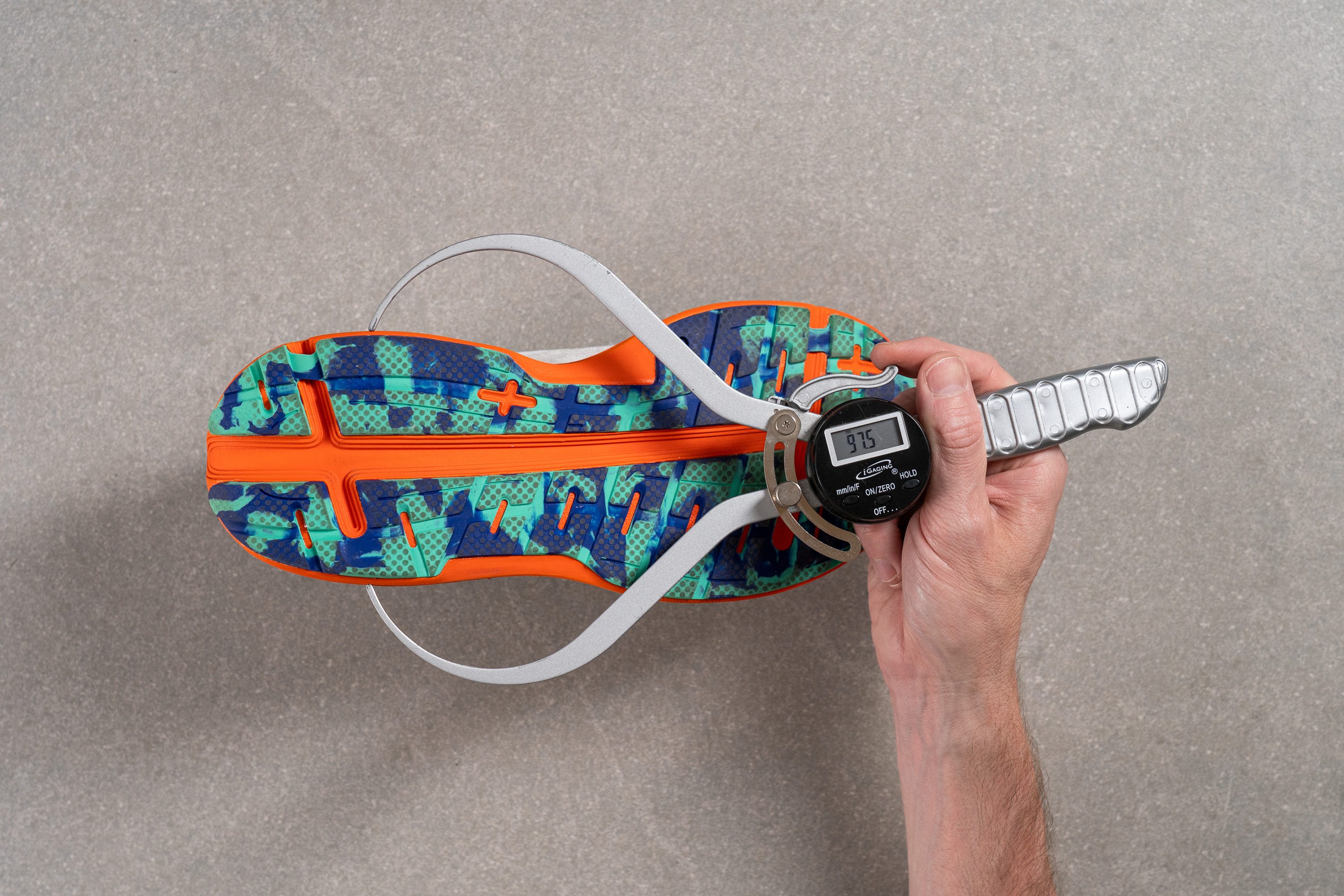
| Aero Glide 2 | 97.5 mm |
| Media | 90.7 mm |
Durabilidad
Durabilidad de la parte delantera
Utilizar una parte superior que no tenga agujeros grandes para el flujo de aire aumenta la durabilidad de forma natural, ya que hay menos puntos débiles en los que puedan producirse daños.
Las Aero Glide 2 son un claro ejemplo de ello, ya que se llevaron un magnífico 4/5 en nuestra prueba Dremel, que es todo un logro para unas zapatillas de running para asfalto.
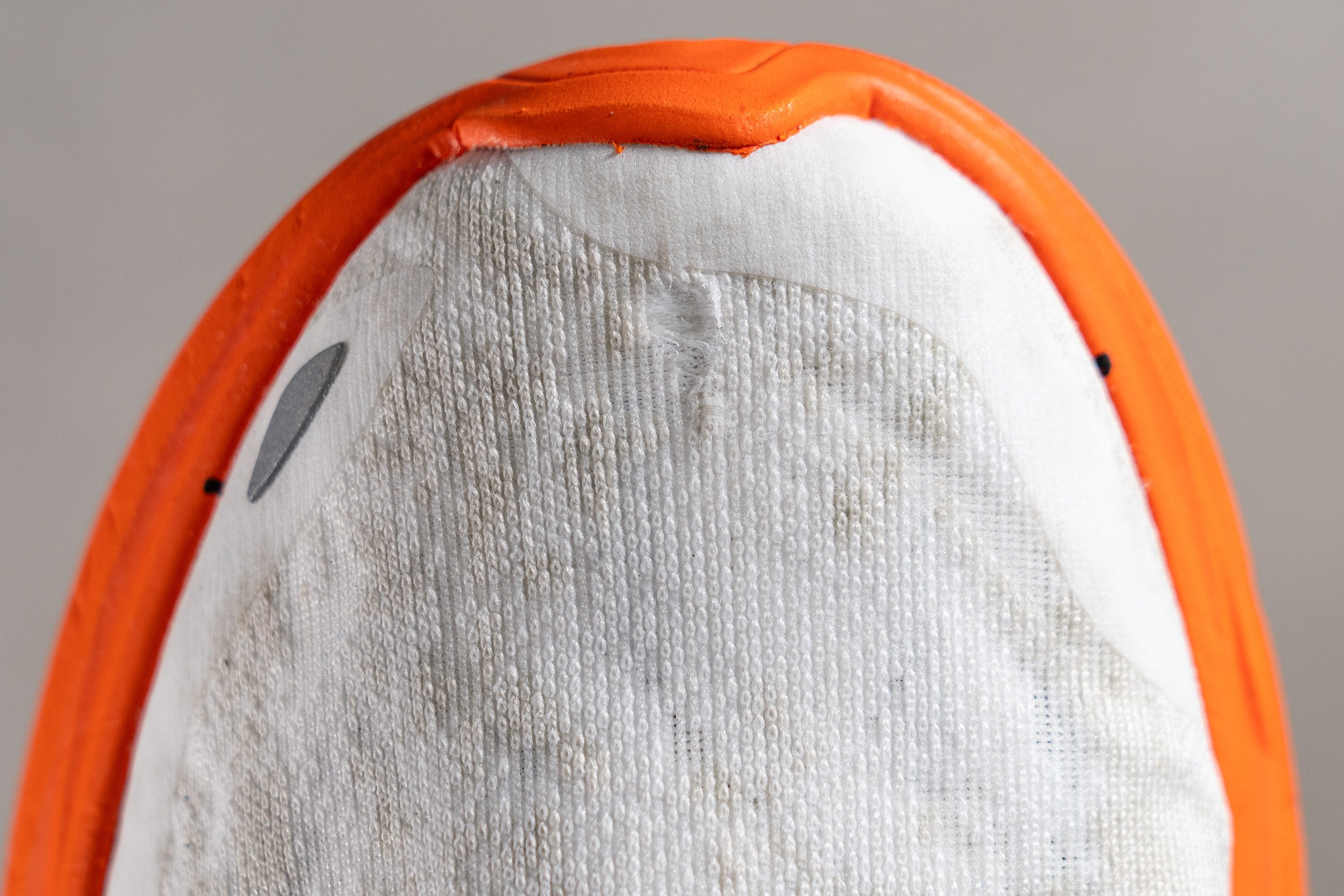
| Aero Glide 2 | 4 |
| Media | 2.6 |
Durabilidad del acolchado del talón
En nuestro laboratorio hemos comprobado que, aunque el acolchado del talón suele tener una mejor durabilidad que la parte delantera, en este caso solo se ha llevado un 3/5.
Aunque este resultado no es preocupante, la verdad es que nos esperábamos más resistencia de unas zapatillas de entrenamiento diario.
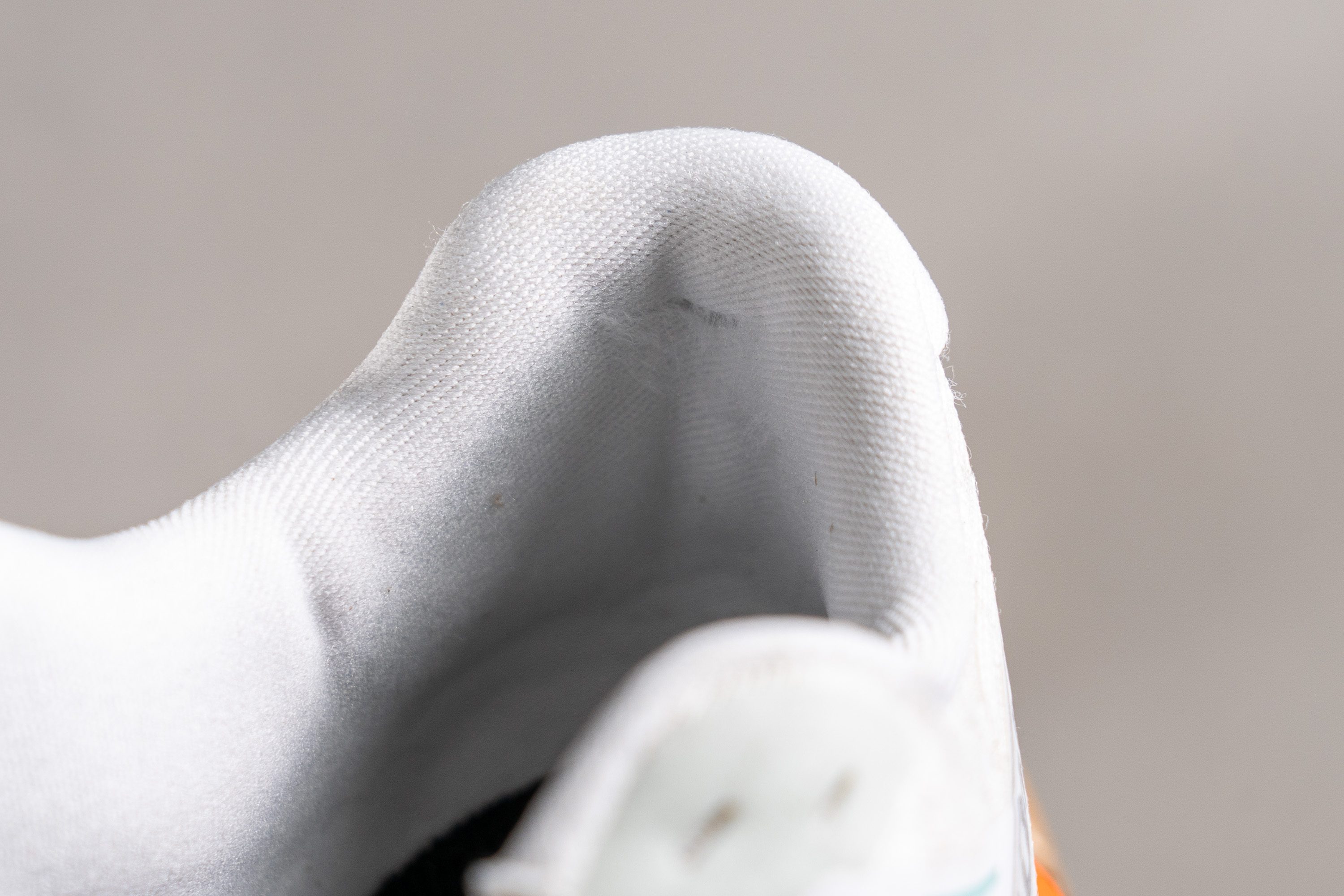
| Aero Glide 2 | 3 |
| Media | 3.4 |
Dureza de la suela
Descubrimos que la tracción es muy eficaz y que no tiene problemas en los senderos bien cuidados o en los caminos de grava. Pero claro, donde más destaca es sobre asfalto.
El caucho CONTAGRIP, que utilizan muchas zapatillas de trail de Salomon, se llevó un resultado de 81,9 HC en nuestro durómetro, así que debería tener una vida útil adecuada.

También descubrimos que la cobertura de caucho de la suela exterior de este modelo destaca entre las zapatillas de entrenamiento diario. Representa un cambio de diseño significativo con respecto a la norma, con un gran corte central y cortes horizontales en el talón y en el antepié.
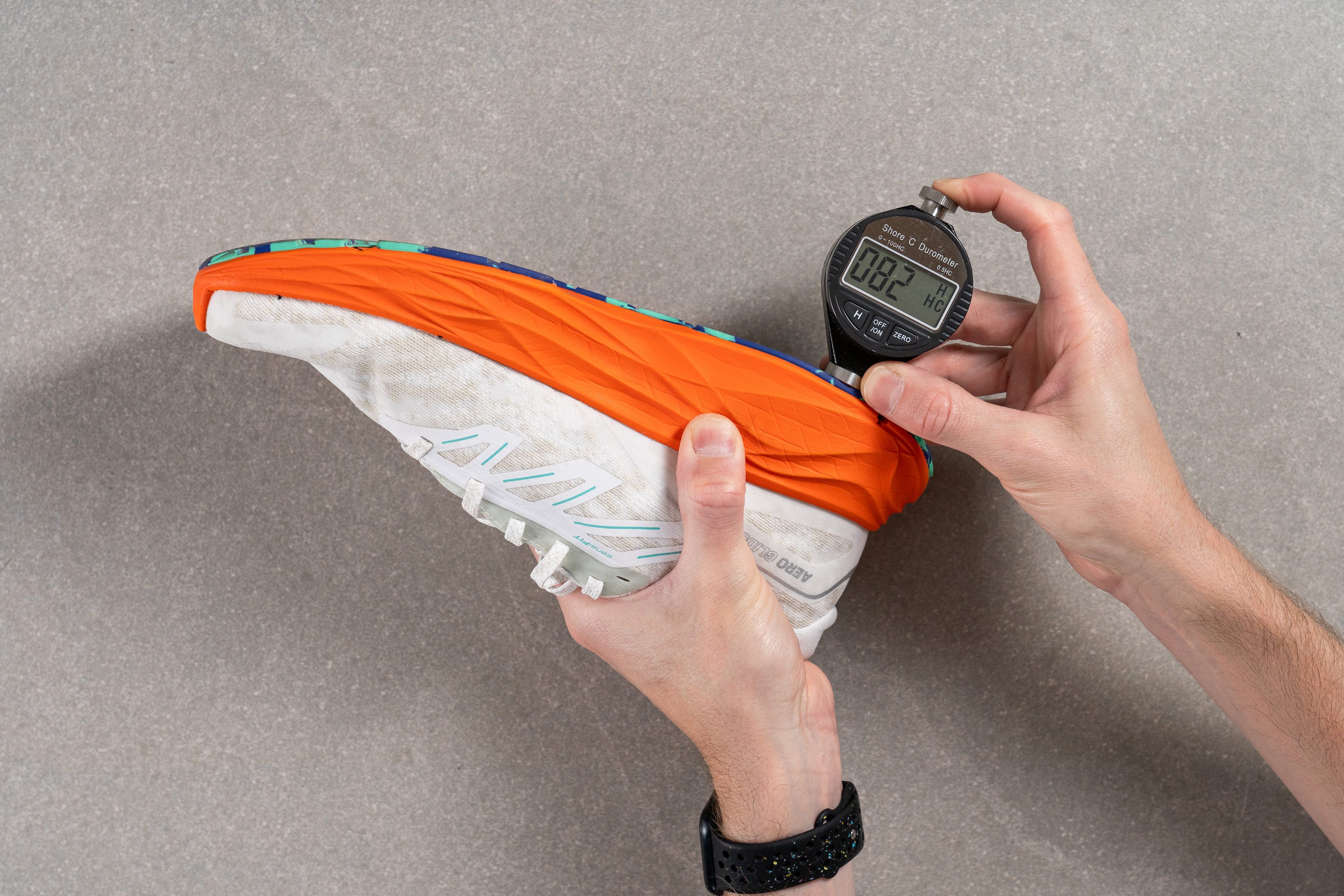
| Aero Glide 2 | 81.9 HC |
| Media | 79.2 HC |
Durabilidad de la suela
Para evaluar la durabilidad del caucho CONTAGRIP echamos mano de nuestro Dremel una vez más.
La suela exterior de las Aero Glide 2 terminó con unos daños moderados de 1,1 mm de profundidad. Es un rendimiento estándar que, aunque no hace que entren en la categoría de los modelos más duraderos, sugiere que la vida útil de este modelo no está nada mal por el grosor y la cobertura del caucho.

| Aero Glide 2 | 1.1 mm |
| Media | 1.1 mm |
Grosor de la suela
Como decíamos, el grosor es un aspecto crucial de la durabilidad. Los 3,4 mm de la suela exterior de este modelo nos dejan claro que los diseñadores de Salomon han conseguido ofrecer un equilibrio excelente, ya que utilizan la cantidad de caucho suficiente para garantizar una vida útil de al menos 650 km sin sumar mucho peso.
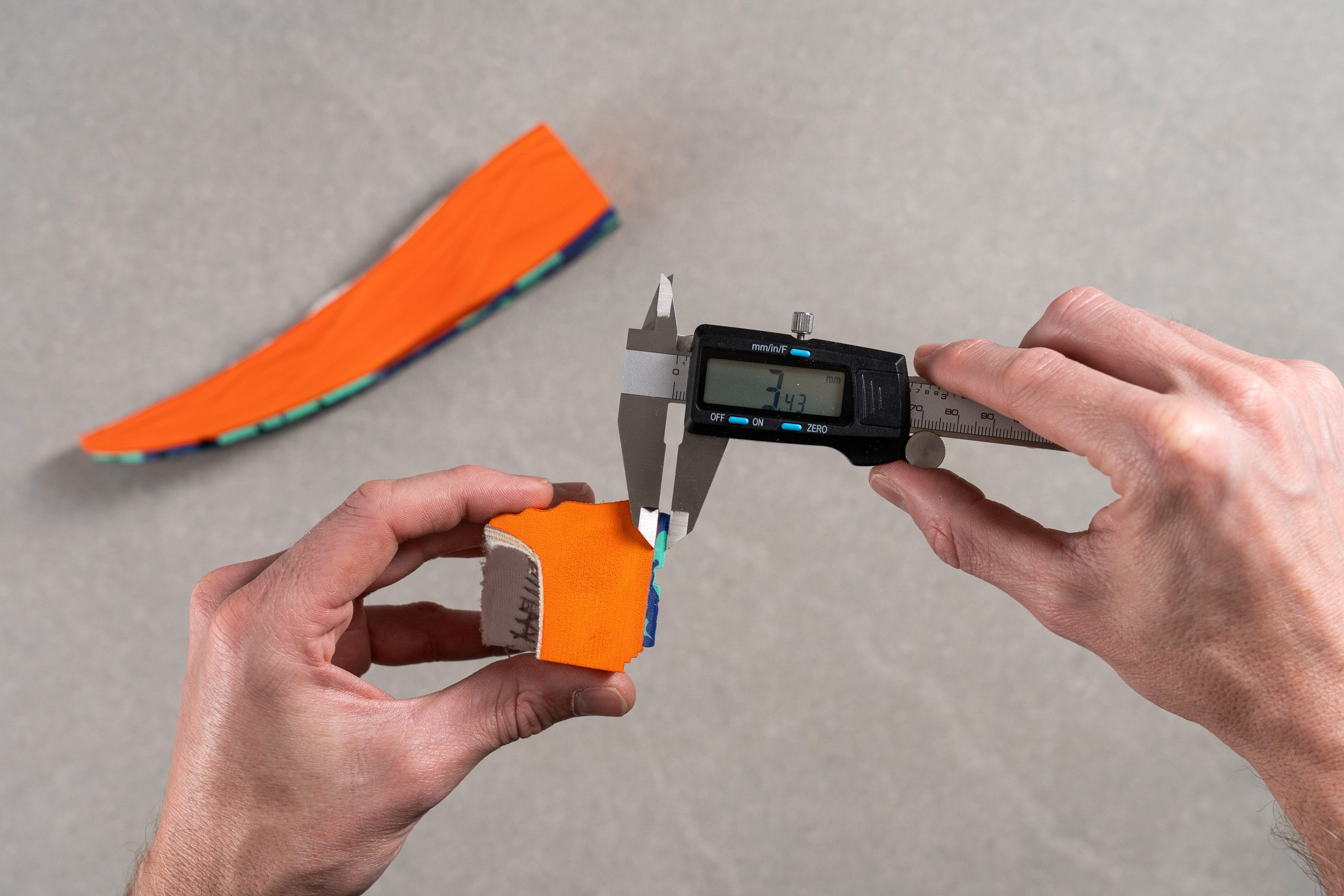
| Aero Glide 2 | 3.4 mm |
| Media | 3.2 mm |
Varios
Grosor de la plantilla
La plantilla Ortholite de las Aero Glide 2 tiene un grosor de 4,1 mm comparable al de la mayoría de zapatillas de entrenamiento diario y que se separa de los modelos de Saucony, que suelen tener plantillas más gruesas.
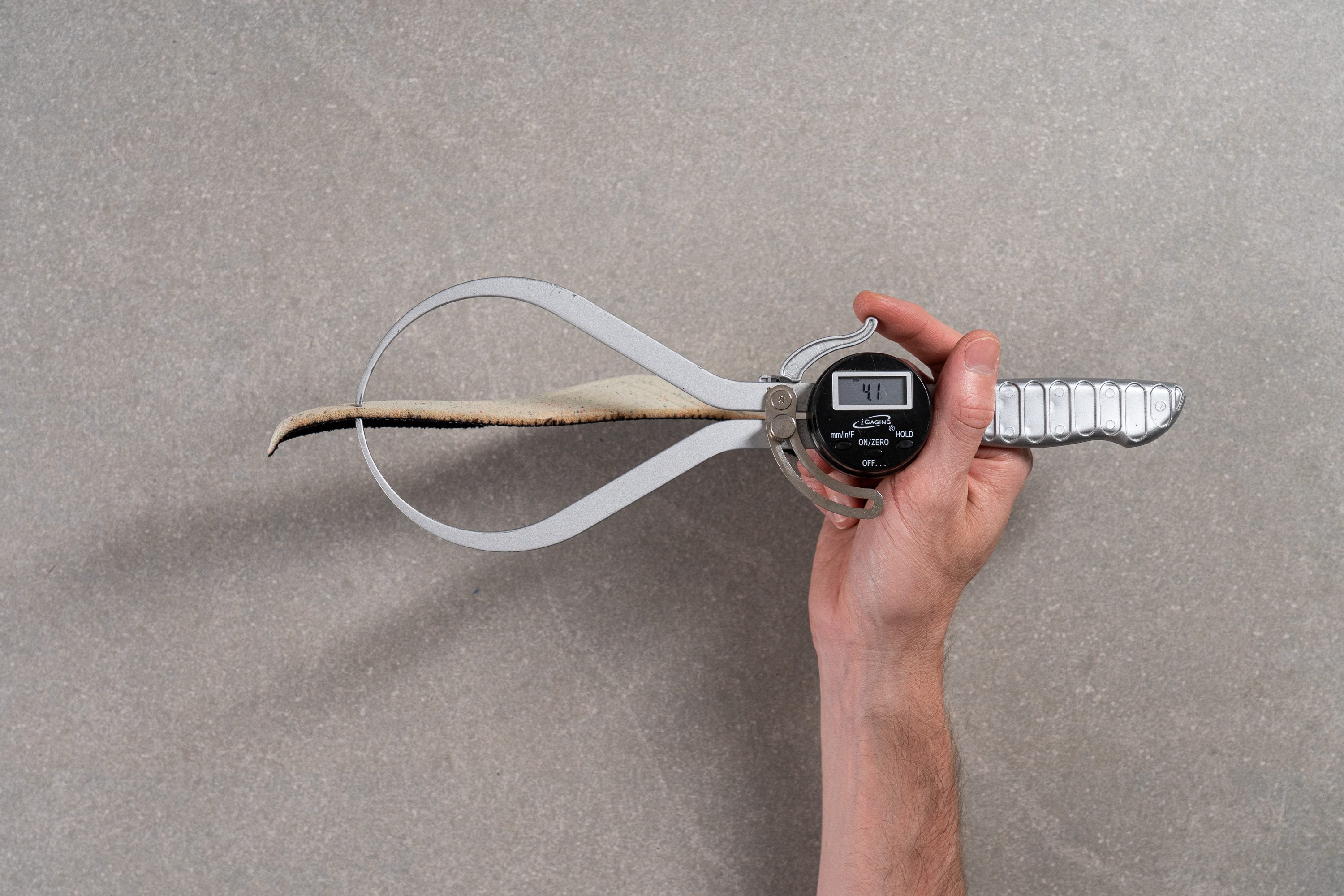
| Aero Glide 2 | 4.1 mm |
| Media | 4.5 mm |
Plantilla extraíble
Pudimos cambiar la plantilla sin problemas, y las dimensiones estándar de estas zapatillas se adaptaron a la que le pusimos sin problema.
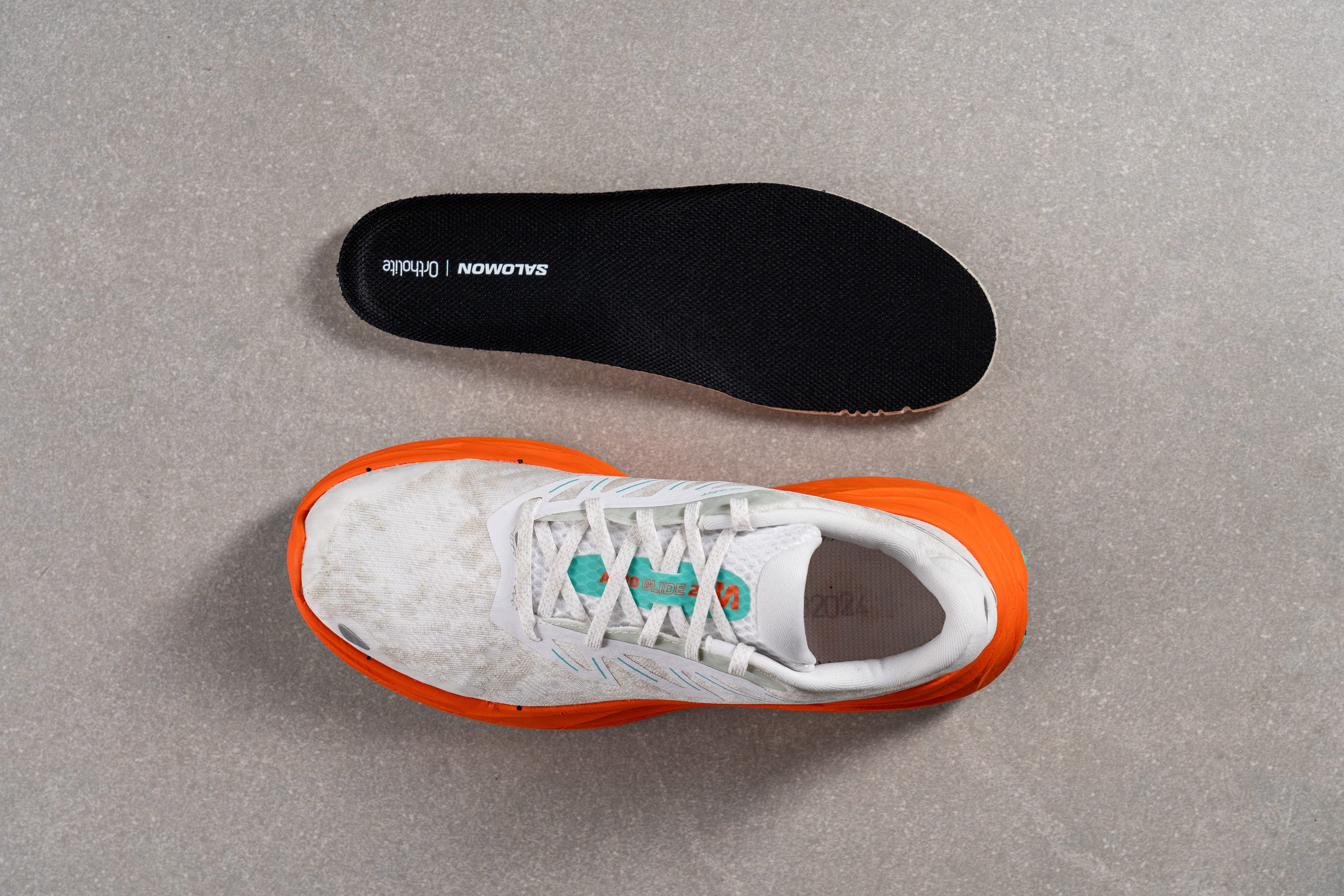
| Aero Glide 2 | Sí |
Rigidez de la mediasuela en frío (%)
Cuando analizamos su rendimiento a baja temperatura, vimos que había un pequeño aumento del 19,5 % en rigidez.
Este rendimiento mejorado ante el frío proviene de la mezcla de OBC (Olefin Block Copolymers) con la base de EVA de la mediasuela, superando así a las espumas EVA estándar.
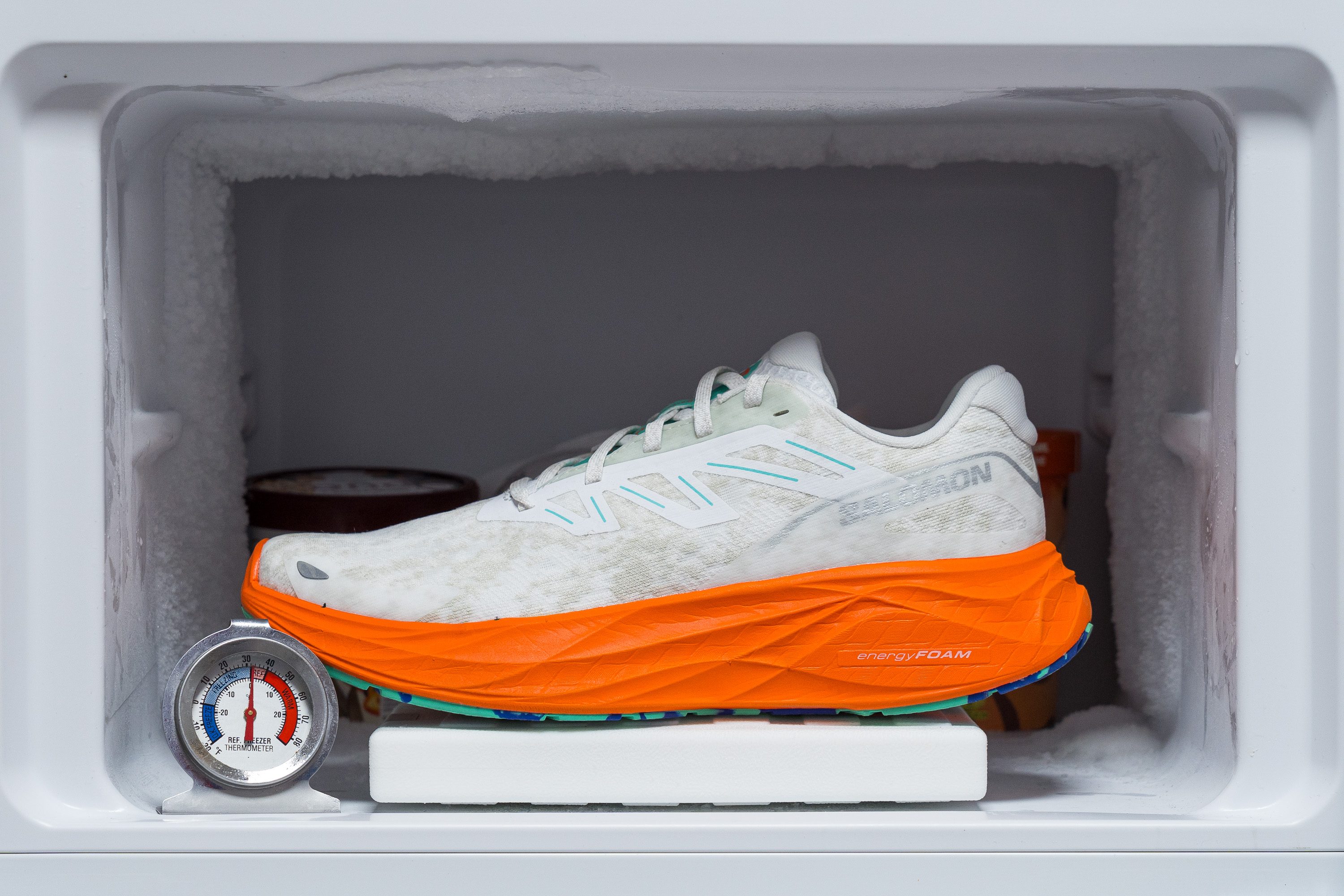
| Aero Glide 2 | 20% |
| Media | 24% |
Elementos reflectantes
Que Salomon haya pasado de las zapatillas de trail a las de asfalto podría explicar la fantástica reflectividad de las Aero Glide 2, porque nosotros no nos la esperábamos para nada, además de que sus predecesoras no tenían elementos reflectantes.
Vimos detalles brillantes colocados estratégicamente a lo largo del talón y en los laterales, consiguiendo una rara reflectividad de 360 grados que diferencia a este modelo de muchos de sus competidores.
| Aero Glide 2 | Sí |
Acolchado de la lengüeta
Aunque la lengüeta no está unida a los laterales, creemos que Salomon ha mejorado mucho en esta prueba. La lengüeta, de 7,9 mm, nos ha parecido muy cómoda sin ser demasiado gruesa, lo que es ideal si estás entrenando para un maratón o corriendo distancias largas.
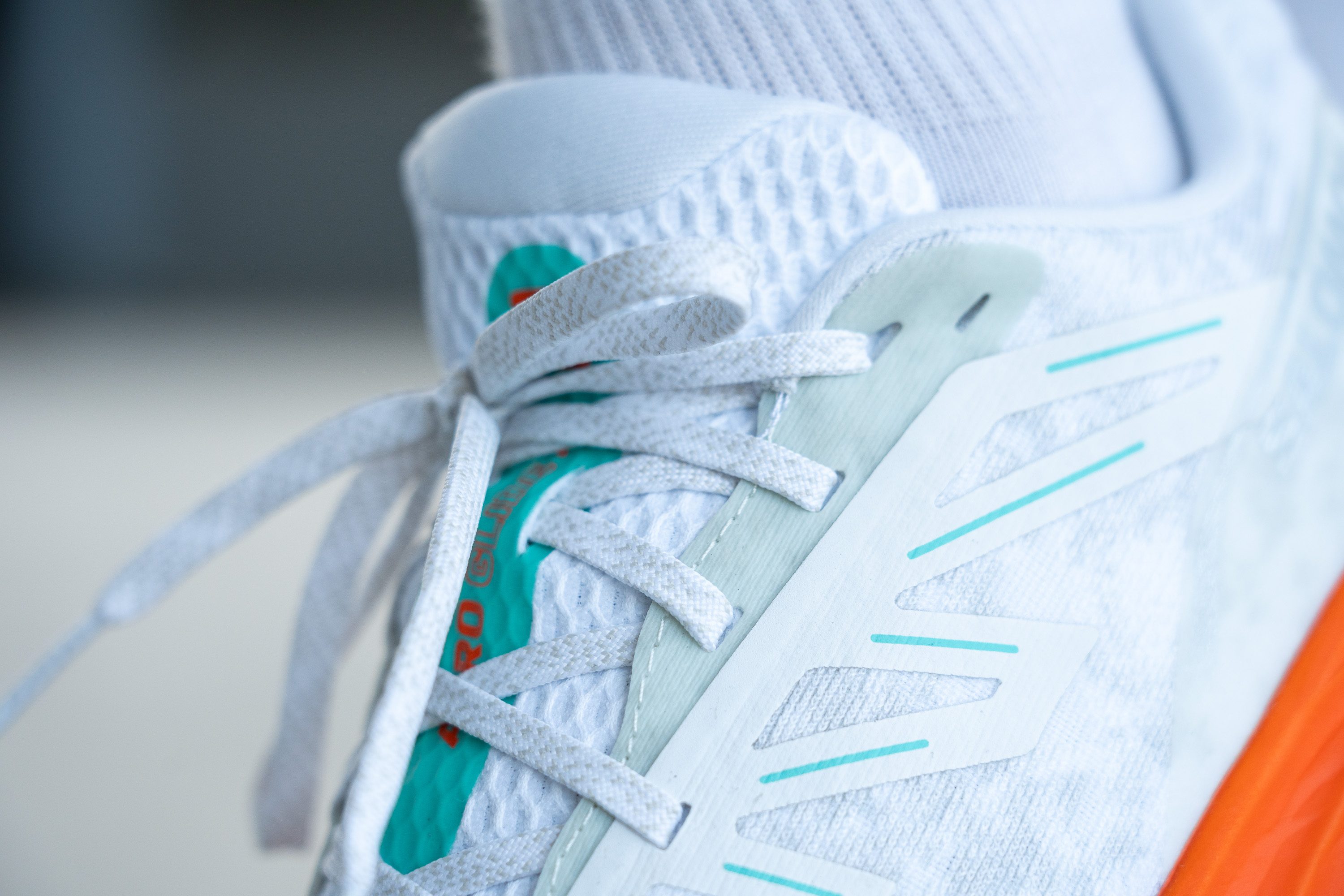
Además, el sistema de cordones nos dejó impresionados, ya que tiene ojales rectangulares que se adaptan perfectamente a los cordones planos. ¡Así se hace, Salomon!

| Aero Glide 2 | 7.9 mm |
| Media | 5.8 mm |
Lengüeta: tipo de refuerzo
Algo que nos ha decepcionado mucho de las Aero Glide 2 es que no tienen una lengüeta reforzada, un defecto difícil de ignorar en unas zapatillas con este precio. Aunque el tirador del talón ofrece una solución parcial, creemos que la siguiente versión tiene que tener una lengüeta reforzada sí o sí, justificando así lo que cuesta este par.

| Aero Glide 2 | Ninguno |
Precio
Las Aero Glide 2 mantienen su precio, que es un detalle que apreciamos mucho en estos momentos, ya que muchas marcas los están subiendo. Además, como cuestan menos que algunos modelos de gama alta como las Saucony Triumph 22, son una buena opción para los corredores que están buscando una buena relación calidad-precio pero con una pequeña experiencia premium al correr.
| Aero Glide 2 | $160 |
Tirador del talón
Al igual que sus predecesoras, las Aero Glide 2 no tienen un tirador en el talón. Aunque no podemos decir que esto sea un problemón, además de que estamos contentos con el acolchado extra de esta zona, nos encantaría que Salomon pensase en ponerle un tirador a la v3.
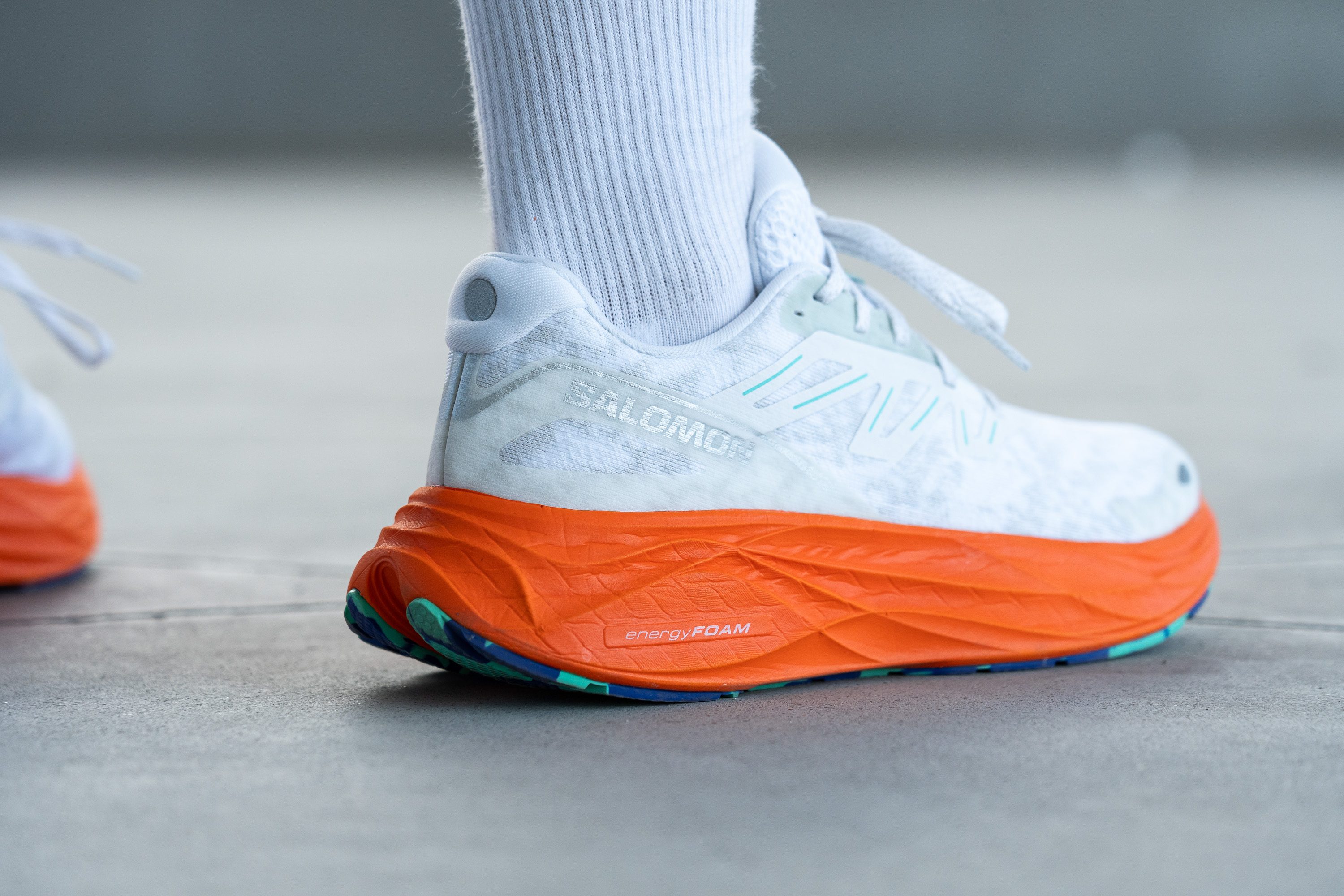
| Aero Glide 2 | Ninguno |

